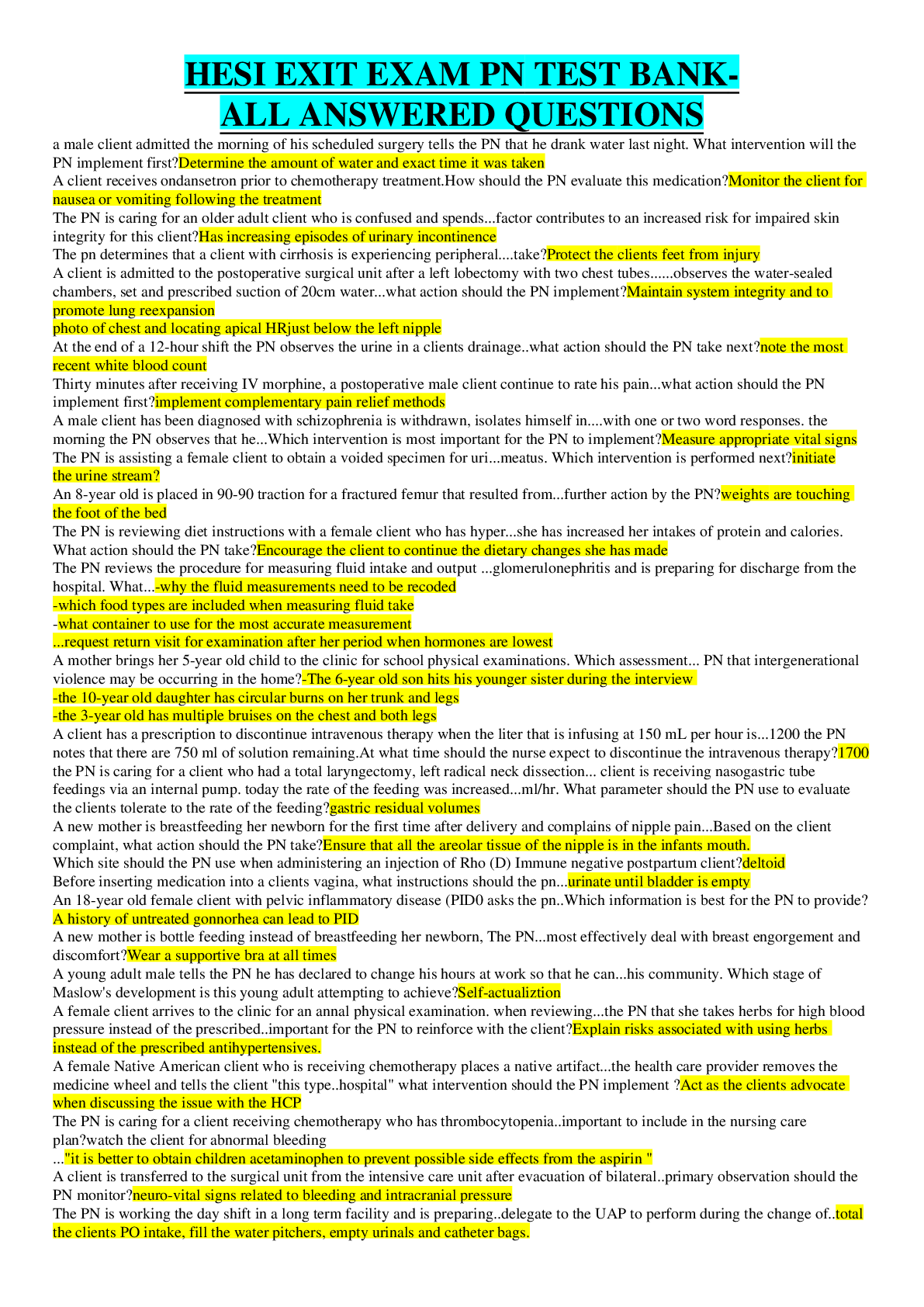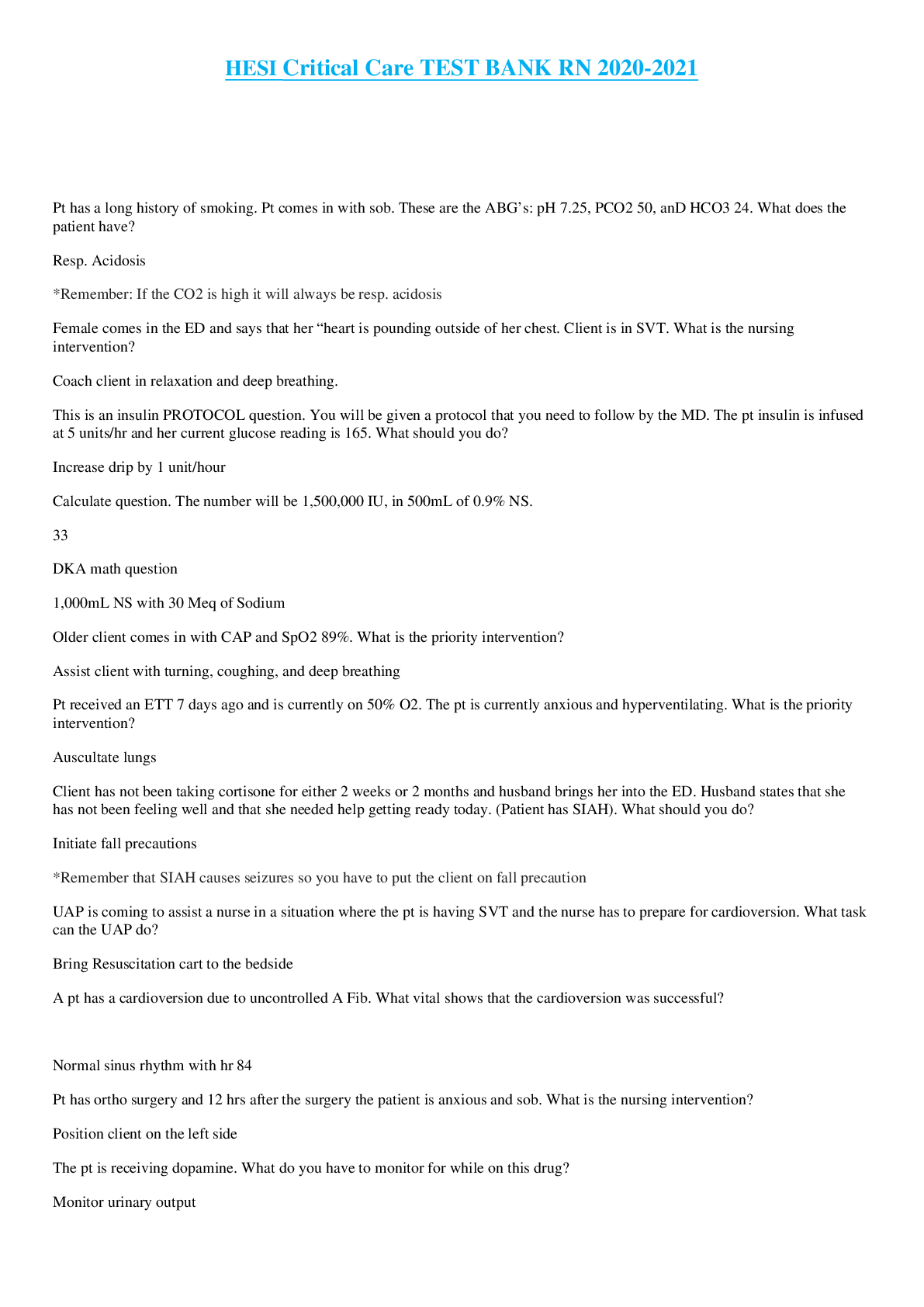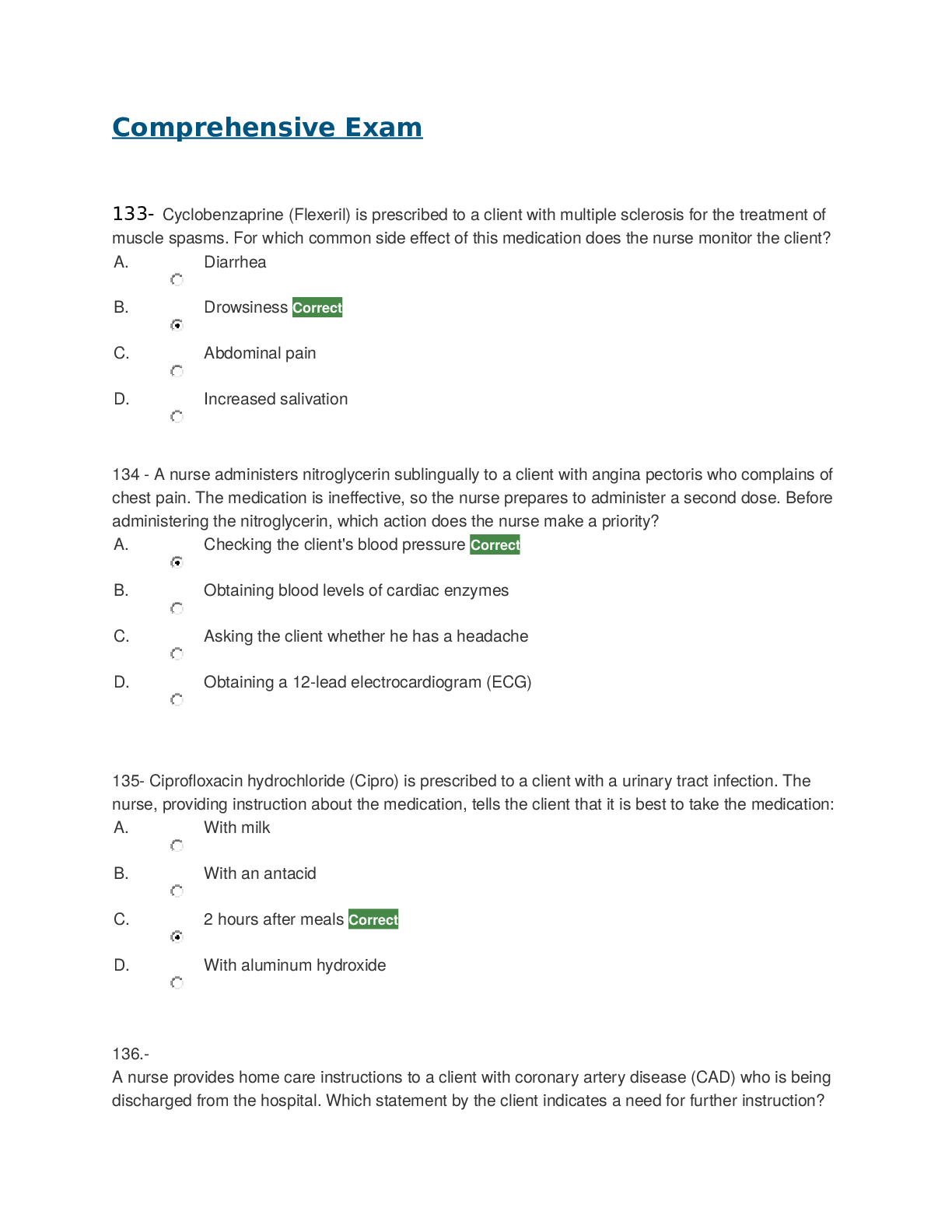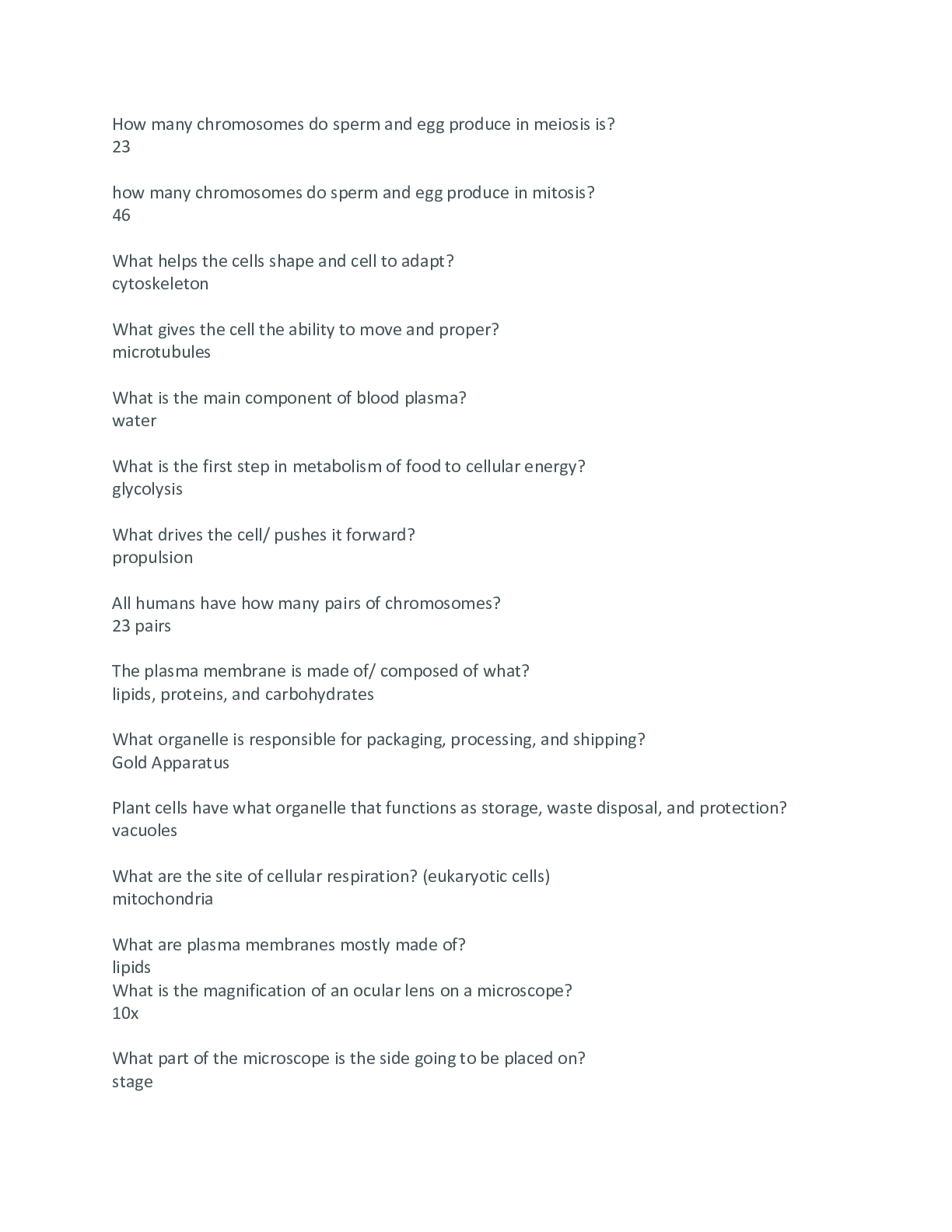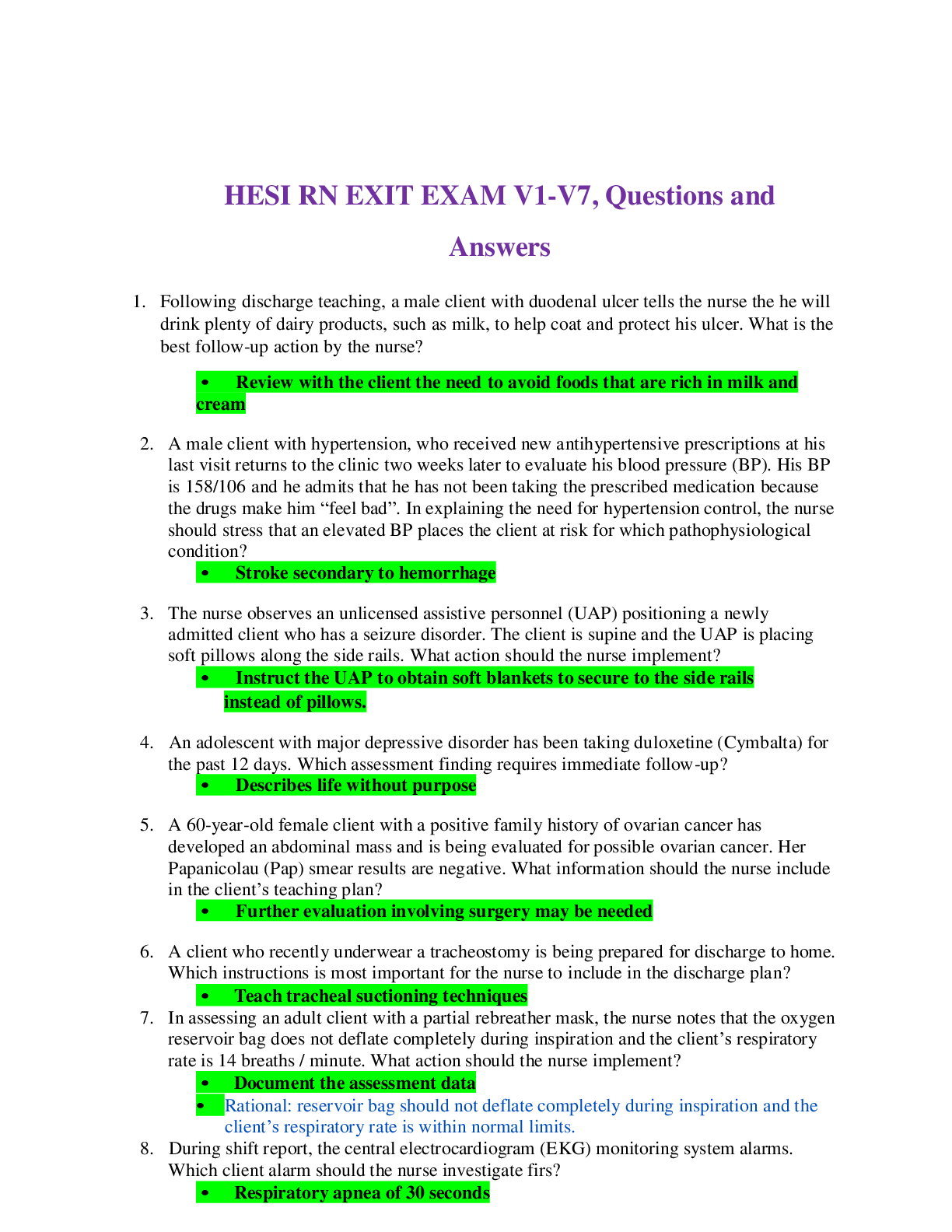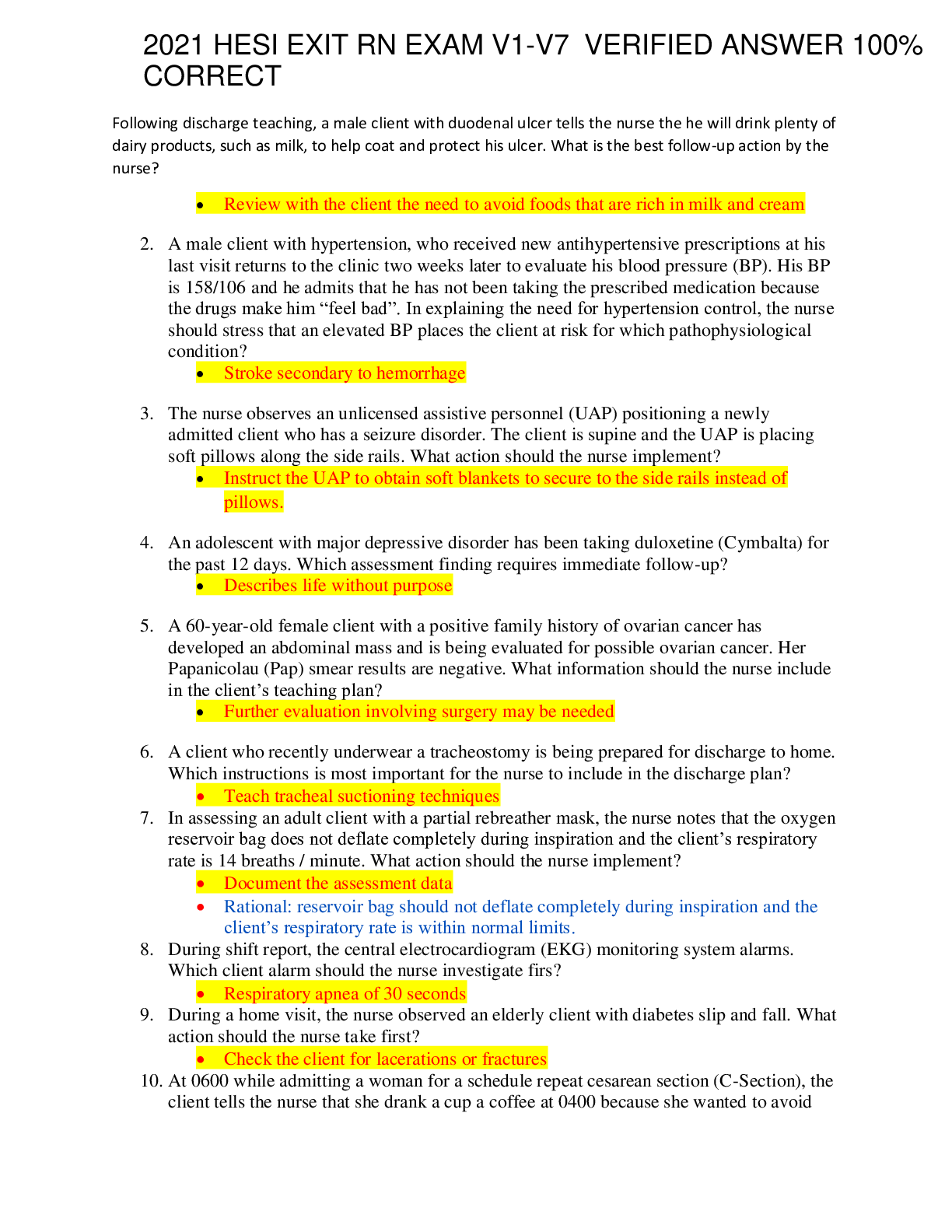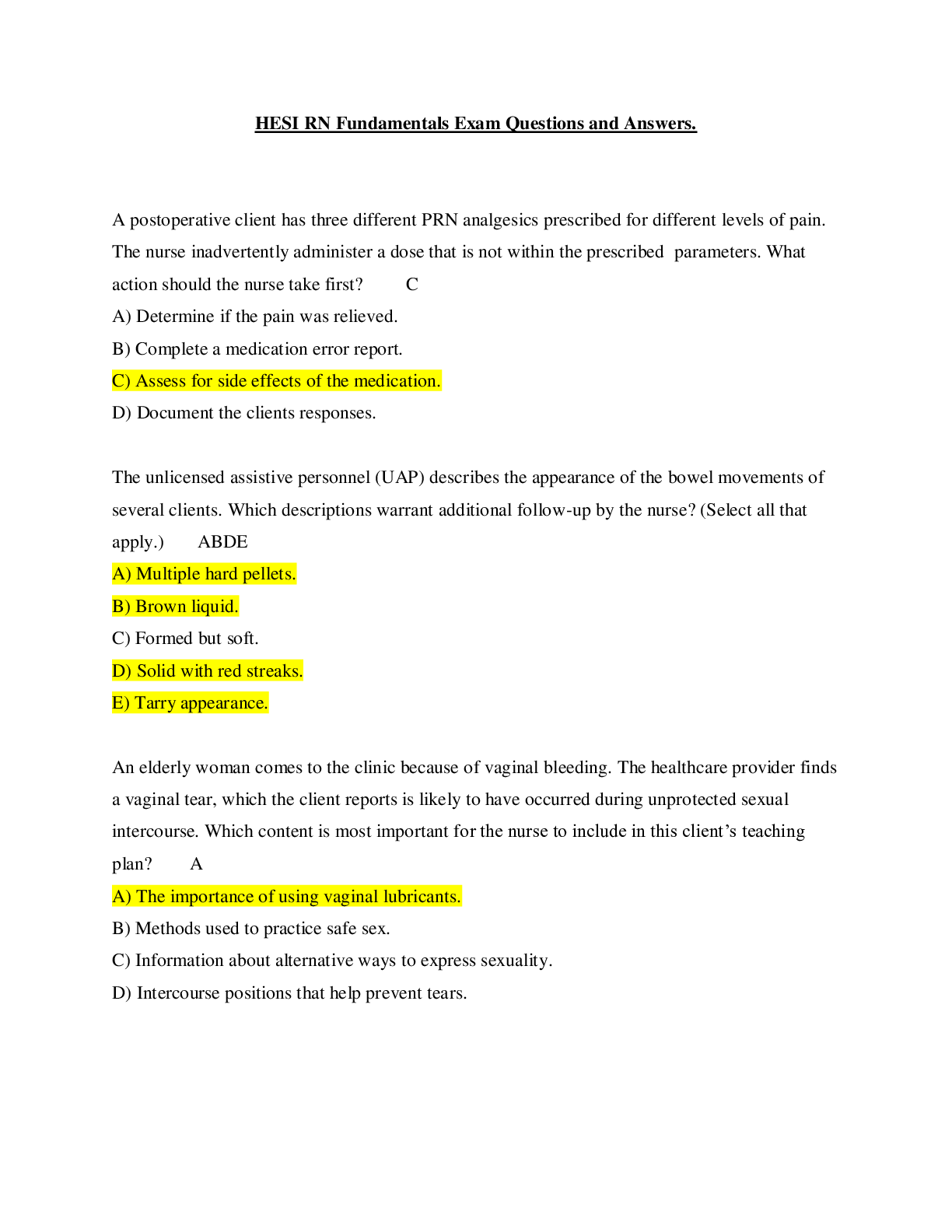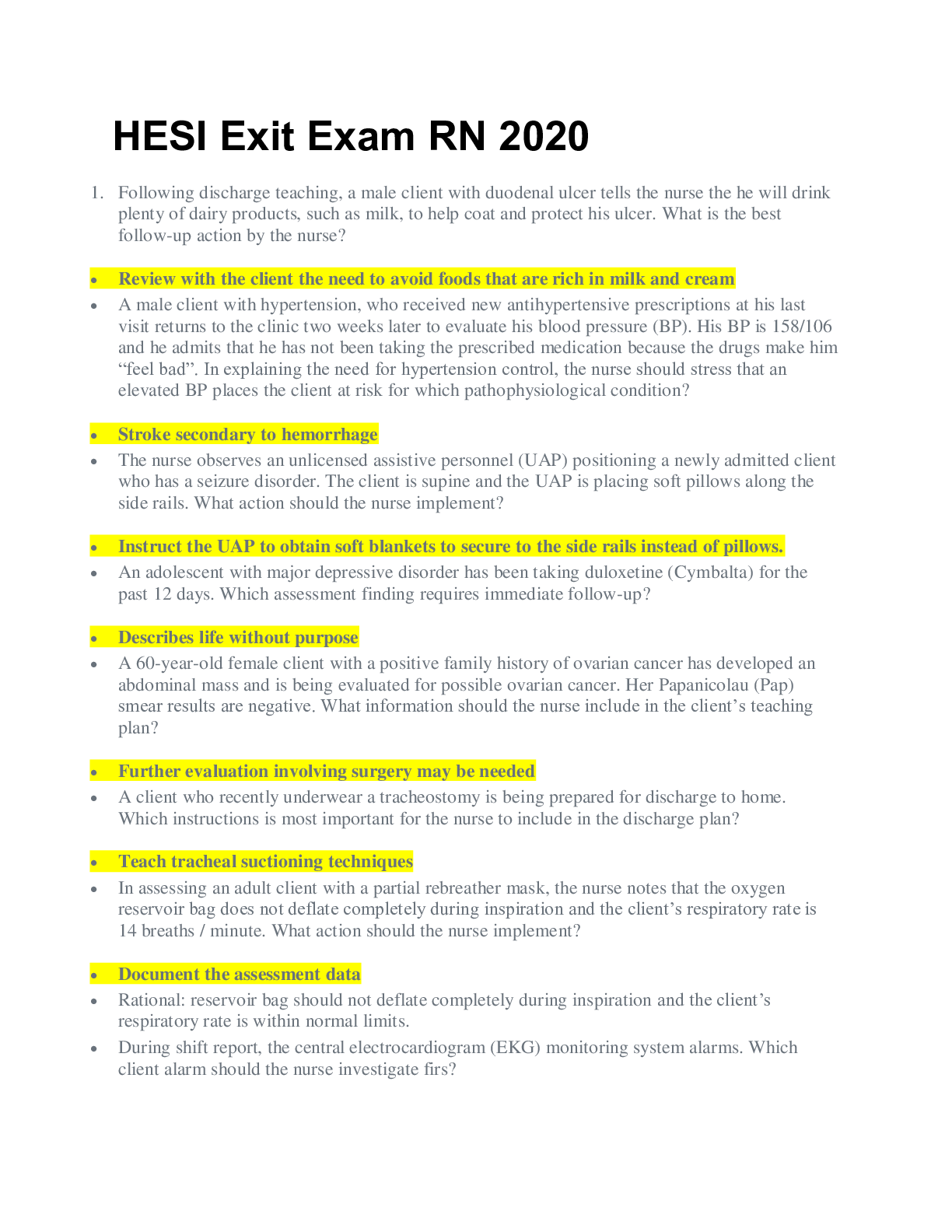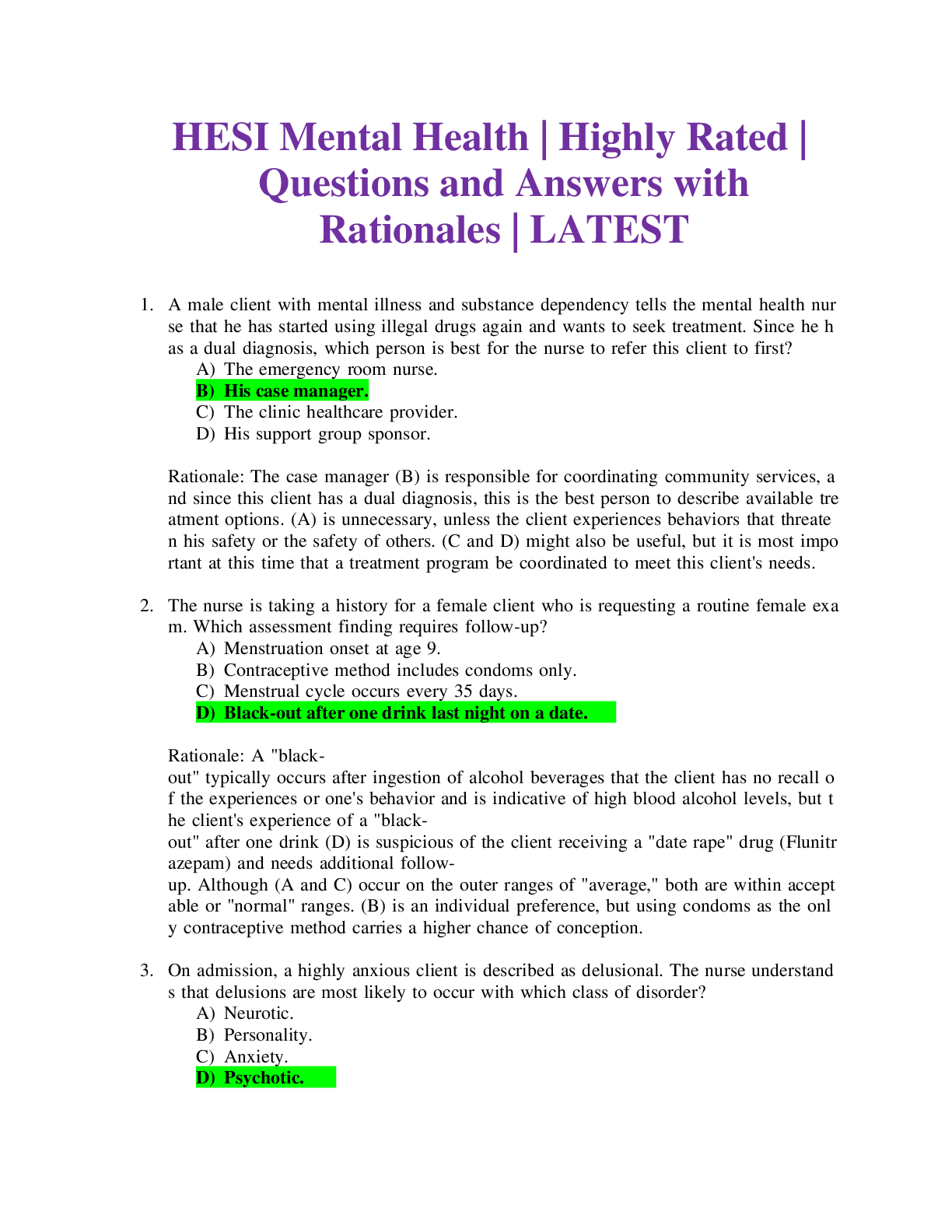*NURSING > HESI > HESI Extra Credit Module 7 Exam with (100 Q&A) rationales | Quick and easy revision | RATED A (All)
HESI Extra Credit Module 7 Exam with (100 Q&A) rationales | Quick and easy revision | RATED A
Document Content and Description Below
1. Questions 1. 1.ID: 9477003586 The nurse is instructing a client with hypertension about foods that are low in sodium. Which menu selections by the client indicate to the nurse that the client und... erstands what has been taught? Select all that apply. A. Spaghetti with fresh tomatoes Correct B. Boiled lobster with baked potato C. Grilled chicken with turnip greens Correct D. Instant hot cereal with bacon E. Tomato soup with a ham sandwich Awarded 2.0 points out of 2.0 possible points. 2. 2.ID: 9477010158 A nurse has provided dietary instructions to a client with a new diagnosis of gout. Which menu suggestions by the client indicate to the nurse that the client needs additional instruction? Select all that apply. A. Carrots B. Tapioca C. Scallops Correct D. Broccoli E. Chicken liver Correct Awarded 2.0 points out of 2.0 possible points. 3. 3.ID: 9477007734 A clear liquid diet has been prescribed for client who has just undergone surgery. Which foods should the nurse offer to the client? Select all that apply. A. Custard B. Apple juice Correct C. Orange juice D. Chicken broth Correct E. Orange gelatin Correct F. Vanilla ice cream Awarded 3.0 points out of 3.0 possible points. 4. 4.ID: 9477011622 Triamterene has been prescribed for a client with a history of hypertension. Which fruits should the nurse tell the client are acceptable to eat while taking this medication? Select all that apply. A. Prunes B. Apples Correct C. Peaches Correct D. Avocados E. Nectarines F. Cranberries Correct Awarded 3.0 points out of 3.0 possible points. 5. 5.ID: 9477000383 Diverticulitis has been diagnosed in a client who has been experiencing episodes of gastrointestinal cramping. The nurse should tell the client to maintain which type of diet, during the asymptomatic period? A. Low in fat B. High in fiber Correct C. Low in residue D. High in carbohydrates Awarded 1.0 points out of 1.0 possible points. 6. 6.ID: 9477011688 A nurse is teaching a client with heart disease about a low-fat diet. Which foods should the nurse tell the client are acceptable to eat? Select all that apply. A. Avocados B. Baked tuna Correct C. Green olives D. Baked potato Correct E. Fresh cherries Correct F. Cream cheese Awarded 3.0 points out of 3.0 possible points. 7. 7.ID: 9477003558 A client with atrial fibrillation has been placed on warfarin sodium. As part of the instructions for the medication, which foods does the nurse tell the client are acceptable to eat? Select all that apply. A. Lettuce B. Cherries Correct C. Broccoli D. Cabbage E. Potatoes Correct F. Spaghetti Correct Awarded 3.0 points out of 3.0 possible points. 8. 8.ID: 9477012954 A regular diet has been prescribed for a client with a leg fracture who has been placed in skeletal traction. Which foods that will promote wound healing does the nurse encourage the client to select from the hospital menu? A. Spare ribs, rice, gelatin, tea B. Pasta, garlic bread, ginger ale C. Chicken breast, broccoli, strawberries, milk Correct D. Peanut butter and jelly sandwich, chocolate cake, tea Awarded 1.0 points out of 1.0 possible points. 9. 9.ID: 9476999160 A client who experienced a stroke (brain attack) is experiencing residual dysphagia. Which foods should the nurse remove from the client’s meal tray? A. Peas Correct B. Scrambled eggs C. Cheese casserole D. Mashed potatoes Awarded 1.0 points out of 1.0 possible points. 10. 10.ID: 9477007710 A client recovering from acute kidney injury (AKI) is being discharged home. The nurse determines that the client understands the therapeutic dietary regimen when the client states that he will plan to eat foods that are low in which substance? A. Fats B. Vitamins C. Potassium Correct D. Carbohydrates Awarded 1.0 points out of 1.0 possible points. 11. 11.ID: 9477002355 A client is resuming eating after undergoing partial gastrectomy. What measures should the nurse tell the client to take to minimize the risk of complications? Select all that apply. A. Lying down after eating Correct B. Eating high-protein foods Correct C. Drinking liquids with meals D. Eating six small meals per day Correct E. Eating concentrated sweets during the day Awarded 3.0 points out of 3.0 possible points. 12. 12.ID: 9477008736 A client with renal calculi is instructed to follow an alkaline ash diet. Which menu choice by the client indicates to the nurse that the client understands the prescribed regimen? A. Chicken, potatoes, and cranberries B. Spinach salad, milk, and a banana Correct C. Peanut butter sandwich, milk, and prunes D. Linguini with shrimp, tossed salad, and a plum Awarded 1.0 points out of 1.0 possible points. 13. 13.ID: 9477002335 A client who has sustained multiple fractures of the left leg is in skeletal traction. The nurse has obtained an overhead trapeze to improve the client’s bed mobility. To which high-risk area must the nurse pay particular attention during assessment for indications of pressure and skin breakdown? A. Left heel B. Scapulae C. Right heel Correct D. Back of the head Awarded 1.0 points out of 1.0 possible points. 14. 14.ID: 9477006347 Which food should the nurse offer to a client who has been prescribed a full liquid diet? A. Toast B. Plain bagel C. Cooked custard Correct D. Scrambled eggs Awarded 1.0 points out of 1.0 possible points. 15. 15.ID: 9477005736 A client with heart failure and hypertension who has been admitted to the hospital is unable to make own selections from the menu. Which meal does the nurse select for the client’s supper on the day of admission? A. Smoked ham, fresh carrots, boiled potato B. Hot dog in a bun, sauerkraut, baked beans C. Turkey, baked potato, salad with oil and vinegar Correct D. Shrimp, baked potato, salad with blue cheese dressing Awarded 1.0 points out of 1.0 possible points. 16. 16.ID: 9477007722 The nurse teaches a client who has begun taking phenelzine, a monoamine oxidase inhibitor (MAOI), about the medication. Which foods are allowed in the diet of the client taking phenelzine? Select all that apply. A. Peas Correct B. Broccoli Correct C. Potatoes Correct D. Red wine E. Avocados F. Cereal with raisins Awarded 3.0 points out of 3.0 possible points. 17. 17.ID: 9477008764 A client with a genitourinary tract infection has been prescribed metronidazole and fluid therapy. The nurse concludes that the client understands the dietary regimen to be followed while taking the medication when the client states to eliminate which from the diet? A. Alcohol Correct B. Diet cola C. Bran flakes D. Chicken livers Awarded 1.0 points out of 1.0 possible points. 18. 18.ID: 9477010198 Calcitriol is prescribed for a client with hypocalcemia. Which foods does the nurse, knowing that they may interfere with calcium absorption, instruct the client to limit in the diet? Select all that apply. A. Bran Correct B. Milk C. Clams D. Spinach Correct E. Orange juice Awarded 2.0 points out of 2.0 possible points. 19. 19.ID: 9477007773 The nurse provides instructions to a client who is beginning therapy with oral theophylline. The nurse recognizes that the client understands the instructions when the client states to limit consumption of which items? A. Coffee, cola, and chocolate Correct B. Oysters, lobster, and shrimp C. Apples, oranges, and pineapple D. Cottage cheese, cream cheese, and dairy creamers Awarded 1.0 points out of 1.0 possible points. 20. 20.ID: 9477007703 A client with a urinary tract infection has been started on nitrofurantoin, a urinary antiseptic medication, and is taught about the foods that will maintain the urinary pH in the acid range. Which food does the nurse tell the client to eliminate from the diet while taking this medication? A. Prunes B. Oranges C. Rhubarb Correct D. Cranberries Awarded 1.0 points out of 1.0 possible points. 21. 21.ID: 9477011664 For which vitamin deficiency should the nurse monitor the client who is on a vegan diet? A. Vitamin A B. Vitamin B12 Correct C. Vitamin C D. Vitamin E Awarded 1.0 points out of 1.0 possible points. 22. 22.ID: 9477006357 A client with cirrhosis has an increased ammonia level. Which diet does the nurse anticipate will be of benefit to the client? A. One low in protein Correct B. One high in fluids C. One high in carbohydrates D. One with a moderate amount of fat Awarded 1.0 points out of 1.0 possible points. 23. 23.ID: 9477006326 A nurse provides dietary instructions to a client with cholecystitis. Which menu selection by the client indicates to the nurse that the client understands the instructions? A. Roast turkey with a baked potato Correct B. Fruit plate with fresh whipped cream C. Fried chicken with macaroni and cheese D. Barbecued spare ribs with buttered noodles Awarded 1.0 points out of 1.0 possible points. 24. 24.ID: 9477002348 A client is found to have ulcerative colitis, and the nurse provides instructions to the client about the diet that should be followed while the disease is in remission. Which menu selection by the client indicates to the nurse that the client best understands the instructions? A. Milk B. Cabbage C. Boiled potatoes Correct D. Coffee with cream Awarded 1.0 points out of 1.0 possible points. 25. 25.ID: 9477005768 A nurse has taught a client with a new colostomy about measures to control stool odor in the ostomy drainage bag. Which foods listed on the client’s shopping list indicate to the nurse that the client has understood the information? Select all that apply. A. Eggs B. Yogurt Correct C. Parsley Correct D. Broccoli E. Cucumbers F. Cranberry juice Correct Awarded 3.0 points out of 3.0 possible points. 26. 26.ID: 9477010118 A nurse is teaching a client with an ileostomy about foods that could result in the production of liquid stools. Which food that just arrived on the client’s meal tray should the nurse discourage the client from eating? A. Bran Correct B. Pasta C. Boiled rice D. Low-fat cheese Awarded 1.0 points out of 1.0 possible points. 27. 27.ID: 9477011634 A client with liver cancer who is undergoing chemotherapy tells the nurse that some foods on the meal tray taste bitter. Which food does the nurse suggest that the client eliminate from the diet, knowing that it is most likely to taste bitter to the client? A. Beef Correct B. Custard C. Potatoes D. Cantaloupe Awarded 1.0 points out of 1.0 possible points. 28. 28.ID: 9476999146 A client with diabetes mellitus who has been taught about dietary management of the disease wishes to have 8 oz (240 ml) of nonfat yogurt with breakfast. The nurse determines that the client understands diet management when the client states that which action will be taken after eating the nonfat yogurt? A. Not eating ice cream for 2 days B. Omitting 8 oz (240 ml) of skim milk from that meal Correct C. Omitting salad dressing and butter at lunchtime D. Eating only half of an allowed meat product at supper Awarded 1.0 points out of 1.0 possible points. 29. 29.ID: 9477006310 A nurse is caring for a client with cirrhosis. As part of the teaching regarding dietary means of minimizing the effects of the disorder, the nurse educates the client about foods that are high in thiamine. The nurse determines that the client has the best understanding of the material if the client states to increase the intake of which foods? Select all that apply. A. Milk B. Peanuts Correct C. Chicken D. Broccoli E. Asparagus Correct F. Whole-grain cereals Correct Awarded 3.0 points out of 3.0 possible points. 30. 30.ID: 9477000395 A nurse is monitoring the nutritional status of a client receiving enteral nutrition. Which parameter does the nurse use to determine the effectiveness of the tube feedings? A. Daily weight Correct B. Serum protein level C. Calorie count sheets D. Daily intake and output records Awarded 1.0 points out of 1.0 possible points. 31. 31.ID: 9477000353 A nurse is instructing a client in the first trimester of pregnancy about nutrition. Which statement by the client indicates the need for further instruction? A. “I need to eat foods high in calcium.” B. “How I eat can affect my baby’s growth.” C. “I need to take vitamins throughout my pregnancy.” D. “My risk for malnourishment is much higher while I’m pregnant.” Correct Awarded 1.0 points out of 1.0 possible points. 32. 32.ID: 9477002314 A client who has recently been started on enteral feedings complains of abdominal cramping and diarrhea. The nurse reviews the nutritional content on the label of the can of feeding solution. Which ingredient is the nurse looking for that may be causing this problem? A. Maltose B. Lactose Correct C. Sucrose D. Fructose Awarded 1.0 points out of 1.0 possible points. 33. 33.ID: 9477003528 A nurse provides dietary instructions to a client with iron-deficiency anemia. Which foods does the nurse recommend to the client? Select all that apply. A. Lentils Correct B. Raisins Correct C. Pineapple D. Egg whites E. Kidney beans Correct F. Refined white bread Awarded 3.0 points out of 3.0 possible points. 34. 34.ID: 9476998563 A client has a serum sodium level of 151 mEq/L (151 mmol/L), and the nurse provides instruction regarding foods to avoid. Which menu choice by the client indicates to the nurse that the client needs further instruction? A. Fish B. Spinach C. Rhubarb D. American cheese Correct Awarded 1.0 points out of 1.0 possible points. 35. 35.ID: 9477003570 A nurse instructs a client at risk for hypokalemia about the foods high in potassium that should be included in the daily diet. Which menu selection, cited by the client as a good source of potassium, indicates to the nurse that the client needs further instruction? A. Pork B. Beef C. Eggs Correct D. Raisins Awarded 1.0 points out of 1.0 possible points. 36. 36.ID: 9477000319 A nurse is providing dietary instructions to a client with tuberculosis. Which foods would the nurse specifically instruct the client to include more of in the daily diet? A. Rice and fish B. Eggs and bacon C. Cereals and broccoli D. Meats and citrus fruits Correct Awarded 1.0 points out of 1.0 possible points. 37. 37.ID: 9477012917 A nurse is providing dietary instructions to a client with uric acid renal calculi. The nurse should provide the client with which instruction? A. To increase the intake of legumes Correct B. That seafood should be included in the diet C. That organ meats should be included in the diet D. To have at least one serving each day of a citrus fruit Awarded 1.0 points out of 1.0 possible points. 38. 38.ID: 9477007779 The nurse instructs a unlicensed assistive personnel (UAP) that a client who is recovering from a myocardial infarction requires a complete bed bath. The nurse would intervene if the nurse observed the UAP doing which? A. Washing the client’s feet B. Washing the client’s chest C. Giving the client a back rub D. Asking the client to wash his arms Correct Awarded 1.0 points out of 1.0 possible points. 39. 39.ID: 9477000362 A nurse asks an unlicensed assistive personnel (UAP) to provide afternoon care to a client. The nurse expects that the UAP will take which action? A. Give the client a complete bed bath B. Ask the client whether he would like to wash his face C. Give the client a back massage and prepare the client for sleep D. Assist the client in washing his hands and face and performing mouth care, offering a bedpan or urinal, and straightening the bed linens Correct Awarded 1.0 points out of 1.0 possible points. 40. 40.ID: 9477000343 A client requires a partial bed bath. The nurse, giving instructions to an unlicensed assistive personnel (UAP) about the bath, tells the UAP to take which action? A. Just wash the client’s hands and face B. Provide mouth care and perineal care only C. Let the client decide what she wants washed D. Bathe the client’s body parts that, if left unbathed, would give rise to discomfort or odor Correct Awarded 1.0 points out of 1.0 possible points. 41. 41.ID: 9476998580 An unlicensed assistive personnel (UAP) is providing morning care to a client with a fractured leg who is in skeletal traction. The nurse determines that the UAP needs instruction regarding the guidelines for client bathing if the UAP is implementing which action? A. Giving the client a complete bed bath Correct B. Pulling the room curtains around the bathing area C. Turning up the thermostat in the client’s room for the bath D. Keeping the side rails (per agency policy)up while away from the client Awarded 1.0 points out of 1.0 possible points. 42. 42.ID: 9477010170 A nurse notes documentation in a client’s medical record indicating that the client is experiencing oliguria. On the basis of this notation, the nurse determines which about the client when planning care? A. Is unable to produce urine B. Is voiding large amounts of urine C. Has difficulty with leakage of urine D. Has a diminished capacity to form urine Correct Awarded 1.0 points out of 1.0 possible points. 43. 43.ID: 9477010108 A nurse is providing information to a mother of a 1-year-old who has asked about bladder-training her child. The nurse should provide which information to the mother? A. That she may start bladder training at any time B. That her child is too young and that she should not yet be worrying about it C. That a child cannot begin to control urination until approximately the age of 24 months Correct D. That bowel training should be started immediately and then begin bladder training in about 1 month Awarded 1.0 points out of 1.0 possible points. 44. 44.ID: 9477008796 A client has been found to have a bladder infection. When planning care, which area of dysfunction would cause the nurse to monitor the client most closely for signs of a kidney infection? A. Urethra B. Nephron C. Glomerulus D. Ureterovesical junction Correct Awarded 1.0 points out of 1.0 possible points. 45. 45.ID: 9477002375 A nurse is caring for a client whose urine output was 25 mL for 2 consecutive hours. When planning care, which client-related factors does the nurse recognize as increasing blood flow to the kidneys? A. Physiological stress B. Release of dopamine Correct C. Release of norepinephrine D. Sympathetic nervous system stimulation Awarded 1.0 points out of 1.0 possible points. 46. 46.ID: 9477008757 A nurse is caring for an older adult client. When planning care, which occurrence does the nurse recognize as part of the normal aging process? A. Tubular reabsorption increases. B. Urine-concentrating ability increases. C. Glomerular filtration rate (GFR) is diminished. Correct D. Medications are metabolized in larger amounts. Awarded 1.0 points out of 1.0 possible points. 47. 47.ID: 9477006374 An adult client rings the call bell and asks the nurse for assistance in getting to the bathroom to void. The nurse assists the clientestimating that the client has approximately how many mL inthe bladder if the client is feeling a sensation of fullness? A. 100 mL B. 250 mL C. 400 mL Correct D. 800 mL Awarded 1.0 points out of 1.0 possible points. 48. 48.ID: 9477002368 A client taking a potassium-retaining diuretic has a serum potassium level of 5.8 mEq/L (5.8 mmol/L). The nurse understands that the kidneys will respond to this via which physiological action? A. Increased sodium retention B. Increased sodium excretion Correct C. Increased glucose retention D. Increased magnesium excretion Awarded 1.0 points out of 1.0 possible points. 49. 49.ID: 9477012902 A nurse has administered a dose of furosemide to a client with diminished urine output. The nurse expects the urine output to increase once the medication has had time to exert an effect on which structure in the kidney? A. Distal tubule B. Loop of Henle Correct C. Collecting duct D. Proximal tubule Awarded 1.0 points out of 1.0 possible points. 50. 50.ID: 9477007797 A client complains of feeling fatigued because of the need to get up several times during the night to urinate. The nurse documents that the client is experiencing which problem? A. Anuria B. Oliguria C. Polyuria D. Nocturia Correct Awarded 1.0 points out of 1.0 possible points. 51. 51.ID: 9477007788 A client tells the nurse that during the past 2 weeks her urine output has been greater than usual. The nurse, gathering subjective data from the client, should most appropriately ask the client about which? A. Has she been regularly exercising B. Has she been experiencing headaches C. Has she been having heavy menstrual cycles D. Has she been drinking an excessive amount of coffee Correct Awarded 1.0 points out of 1.0 possible points. 52. 52.ID: 9477005722 A nurse is caring for a client who has a fever and is diaphoretic. The nurse monitors the client’s urinary output and laboratory values, anticipating which about the client? A. Urine output will be decreased Correct B. Urine production will be increased C. Serum osmolality will be decreased D. Urine specific gravity will decreased Awarded 1.0 points out of 1.0 possible points. 53. 53.ID: 9477007746 A nurse is instructing a client about the foods that will acidify the urine and inhibit the growth of microorganisms. Which foods does the nurse tell the client are most likely to acidify the urine? Select all that apply. A. Plums Correct B. Prunes Correct C. Apples D. Broccoli E. Cabbage F. Cranberries Correct Awarded 3.0 points out of 3.0 possible points. 54. 54.ID: 9477011654 A nurse is caring for a client who has just returned from a cardiac catheterization through the right side of the groin. The client tells the nurse that he feels the urge to urinate. The nurse assists the client in using a urinal, but the client is unable to void. Which action should the nurse take to stimulate the client’s micturition reflex? A. Helping the client stand B. Elevating the head of the bed 90 degrees C. Turning on the water in the sink in the client’s room and allowing it to run Correct D. Obtaining assistance to ambulate the client to the bathroom in the client’s room Awarded 1.0 points out of 1.0 possible points. 55. 55.ID: 9477012984 A nurse provides information to a client about the importance of consuming fluids every day. If the client has no renal or cardiac disease or any other disorder requiring fluid alterations, how many milliliters of fluid should the nurse recommend that the client consume each day? A. 500 to 1000 mL B. 1000 to 1500 mL C. 1500 to 2000 mL D. 2000 to 2500 mL Correct Awarded 1.0 points out of 1.0 possible points. 56. 56.ID: 9476999154 A nurse provides instructions to a female client regarding the procedure for collecting a midstream urine specimen. What should the nurse tell the client? A. That she should douche before collecting the specimen B. That she should cleanse the perineum from front to back Correct C. That she should collect the urine in the cup as soon as the urine flow begins D. That she should collect the specimen at bedtime and bring it to the laboratory the next morning Awarded 1.0 points out of 1.0 possible points. 57. 57.ID: 9477006395 A nurse is monitoring a client’s fluid balance. Which 24-hour intake and output totals indicates to the nurse that the client has the proper fluid balance? A. Intake 1600 mL, output 800 mL B. Intake 1500 mL, output 1400 mL Correct C. Intake 2400 mL, output 2900 mL D. Intake 3000 mL, output 2400 mL Awarded 1.0 points out of 1.0 possible points. 58. 58.ID: 9477005793 A health care provider states that a client’s insensible fluid loss is approximately 600 mL/day. The nurse interprets this statement to reflect fluid loss occurring through which routes? A. Wound drain and skin B. Skin and mechanical ventilator Correct C. Nasogastric tube and wound drain D. Foley catheter and nasogastric tube Awarded 1.0 points out of 1.0 possible points. 59. 59.ID: 9476999179 A nurse has taught a client how to ambulate with the use of a cane. The nurse determines that the client needs additional instruction if which is observed? A. The client holds the cane close to the body B. The client holds the cane on the unaffected side C. The client moves the cane and the unaffected side together Correct D. The client uses the cane to support the affected side and to maintain balance Awarded 1.0 points out of 1.0 possible points. 60. 60.ID: 9477012944 A nurse provides instructions to a client about preventing injury while using crutches. The nurse tells the client to avoid resting the underside of the arm on the crutch pad, mainly because it could result in which problem? A. Skin breakdown B. Injury to the nerves Correct C. An abnormal stance D. A fall and further injury Awarded 1.0 points out of 1.0 possible points. 61. 61.ID: 9477008725 A nurse has taught a client how to stand on crutches. The nurse determines that the client understands the instructions if the client places the crutches in which position? A. 2 inches (5 cm) to the front and side of the toes B. 8 inches (20 cm) to the front and side of the toes Correct C. 15 inches (38 cm) to the front and side of the toes D. 22 inches (56 cm) to the front and side of the toes. Awarded 1.0 points out of 1.0 possible points. 62. 62.ID: 9477003506 A nurse is providing instructions to a client regarding the use of crutches. Which information should the nurse include in the teaching plan? Select all that apply. A. It is not safe to use someone else’s crutches. Correct B. Rubber crutch tips will not slip, even when wet. C. The client should use both crutches when navigating stairs. Correct D. Lean into the crutches as needed to support the body’s weight. E. Crutch tips are made of a material that will not wear down. Awarded 2.0 points out of 2.0 possible points. 63. 63.ID: 9477011646 A client with right-sided weakness must learn how to use a cane. The nurse tells the client to position the cane by holding it in which way? A. Left hand, 6 inches (15 cm) lateral to the left foot Correct B. Right hand, 6 inches (15 cm) lateral to the right foot. C. Left hand, placing the cane in front of the left foot D. Right hand, placing the cane in front of the right foot Awarded 1.0 points out of 1.0 possible points. 64. 64.ID: 9477012964 A nurse is evaluating the client’s use of a cane for left-sided weakness. The nurse determines that the client needs further teaching if the client is observed doing what? A. Holds the cane on the right side B. Moves the cane when the right leg is moved Correct C. Leans on the cane when the right leg moves forward D. Keeps the cane 6 inches (15 cm) out to the side of the right Awarded 1.0 points out of 1.0 possible points. 65. 65.ID: 9477000307 A nurse is repositioning a client who has returned to the nursing unit after internal fixation of a fractured right hip. The nurse should use which for repositioning? A. Pillow to keep the right leg abducted while turning the client Correct B. Rolled bath blanket to prevent abduction while turning the client C. Trochanter roll to keep the right leg adducted while turning the client D. Rolled bath blanket to prevent external rotation while turning the client Awarded 1.0 points out of 1.0 possible points. 66. 66.ID: 9476999100 A nurse has a prescription to get the client out of bed and into a chair on the first postoperative day after total knee replacement. Which action should the nurse take to protect the knee? A. Assisting the client into the chair, using a walker to minimize weight bearing on the affected leg B. Securely covering the surgical dressing with an elastic wrap and applying ice to the knee while the client is sitting C. Lifting the client to the bedside chair, leaving the continuous passive motion (CPM) machine in place. D. Applying a knee immobilizer before getting the client up, then elevating the affected leg while the client is sitting Correct Awarded 1.0 points out of 1.0 possible points. 67. 67.ID: 9477010149 The nurse is supervising an unlicensed assistive personnel (UAP)in caring for a client who has just undergone lumbar spinal fusion after herniation of a lumbar disc. Which action by the UAP while repositioning the client would cause the nurse to intervene? A. Keeping the head of the bed flat B. Placing pillows beneath the full length of the legs C. Using a log-rolling technique for repositioning D. Having the client assist by using the overhead trapeze Correct Awarded 1.0 points out of 1.0 possible points. 68. 68.ID: 9477010128 A nurse has taught the client with a herniated lumbar disk about proper body mechanics and other information about low back care. The nurse determines that the client needs further instruction if the client makes which statement? A. “I should bend at the knees to pick things up.” B. “I need to increase the fiber and fluids in my diet.” C. “I can strengthen my back muscles by swimming or walking.” D. “I should get out of bed by sitting up straight and swinging my legs over the side of the bed.” Correct Awarded 1.0 points out of 1.0 possible points. 69. 69.ID: 9476999170 A client has been placed in Buck’s extension traction. The nurse can provide counter traction to reduce shear and friction by implementing which measure? A. Flexing the feet against a footboard B. Slightly elevating the foot of the bed Correct C. Keeping the head of the bed elevated 45 degrees D. Placing the bed in reverse Trendelenburg position Awarded 1.0 points out of 1.0 possible points. 70. 70.ID: 9477010138 A nurse is inserting an indwelling urinary catheter into the urethra of a male client. As the nurse inflates the balloon, the client complains of discomfort. The nurse should take which action? A. Asking the client to take slow, deep breaths B. Removing the catheter and contacting the health care provider (HCP) C. Aspirating the fluid, advancing the catheter farther, and reinflating the balloon Correct D. Aspirating the fluid, withdrawing the catheter slightly, and reinflating the balloon Awarded 1.0 points out of 1.0 possible points. 71. 71.ID: 9477011674 A nurse is inserting an indwelling urinary catheter into a female client. As the catheter is inserted into the urethra, urine begins to flow into the tubing. At this point, the nurse should take which action? A. Immediately inflate the balloon B. Insert the catheter 2.5 to 5 cm and inflate the balloon Correct C. Wait until the urine flow stops and inflate the balloon D. Insert the catheter until resistance is met and inflate the balloon Awarded 1.0 points out of 1.0 possible points. 72. 72.ID: 9477005746 A nurse is preparing to administer an enema to a client. In which position does the nurse place the client? A. B. C. Correct D. Awarded 1.0 points out of 1.0 possible points. 73. 73.ID: 9477011611 A nurse is providing information to the mother of an 18-month-old about bowel training. The nurse should provide the mother with which information? A. The child should be able to control defecation at the age of 18 months B. The child will let you know when she is ready to begin bowel training C. Girls usually achieve the neuromuscular development necessary for controlling defecation much sooner than boys do D. The neuromuscular development needed to control defecation does not take develop until 2 to 3 years of age Correct Awarded 1.0 points out of 1.0 possible points. 74. 74.ID: 9477012928 A nurse is developing a plan of care for an older client who is being admitted to a long-term care facility. Which intervention should the nurse include in the plan of care to help maintain an appropriate bowel elimination pattern? A. Limiting vegetable intake to one serving per day B. Limiting whole grains to three servings per week C. Providing cooked fruits such as prunes or apricots Correct D. Including spicy foods in the diet to increase peristalsis Awarded 1.0 points out of 1.0 possible points. 75. 75.ID: 9477006384 A nurse is developing a bowel-training program for a client after a stroke. Which interventions are appropriate for inclusion in the plan? Select all that apply. A. Providing privacy and time for defecation Correct B. Assisting the client into a sitting position Correct C. Limiting the amount of fiber in the client’s diet D. Providing a cool drink before defecation time E. Initiating defecation measures every day at the same time Correct F. Administering a cathartic suppository a half-hour before defecation time Correct Awarded 4.0 points out of 4.0 possible points. 76. 76.ID: 9477012972 A cleansing enema is prescribed for an adult client. The nurse understands that which is the maximal volume of fluid that can be administered? A. 250 mL B. 500 mL C. 750 mL D. 1000 mL Correct Awarded 1.0 points out of 1.0 possible points. 77. 77.ID: 9477005705 A nurse administers a tap water enema to an adult client who is constipated. The client defecates a scant amount of brown fecal matter, which the nurse interprets as a poor result. The nurse should take which action? A. Document the results Correct B. Administer a second tap water enema C. Add soap suds to the enema bag and repeat the enema D. Administer a Fleet enema, then a tap water irrigation Awarded 1.0 points out of 1.0 possible points. 78. 78.ID: 9477003542 A nurse administers an oil retention enema to a client. Afterward, the nurse should provide which instruction to the client? A. Immediately expel the enema B. Retain the enema for several hours Correct C. Expect to defecate within 30 minutes D. Expect to experience cramping induced by the solution Awarded 1.0 points out of 1.0 possible points. 79. 79.ID: 9477006367 A nurse is administering a high cleansing enema. At what level above the client’s hips should the nurse place the enema bag? A. 4 inches (10 cm) B. 8 inches (20 cm) C. 10 inches (25.5 cm) D. 18 inches (45.5 cm) Correct Awarded 1.0 points out of 1.0 possible points. 80. 80.ID: 9477014204 The health care provider (HCP) prescribes “enemas until clear” for a client. The nurse has administered three enemas to the client, but the client is still passing brown stool and fluid. Which action should the nurse take? A. Notify the HCP Correct B. Continue administering enemas until the fluid returns clear C. Administer a glycerin suppository and then administer one more enema D. Allow the client to rest for 1 hour and then continue with another enema Awarded 1.0 points out of 1.0 possible points. 81. 81.ID: 9477002396 A nurse is preparing to administer a soap suds enema to an adult client. After explaining the procedure and positioning the client, the nurse begins the procedure. The nurse inserts the rectal tube into the client’s rectum a maximal distance of of how many inches? A. 1½ inches (3.8 cm) B. 3 inches (7.5 cm) C. 4 inches (10 cm) Correct D. 6 inches (15 cm) Awarded 1.0 points out of 1.0 possible points. 82. 82.ID: 9477008786 A nurse is administering an enema to a client. While the enema solution is being instilled, the client complains of abdominal cramping. Which action should the nurse take? A. Clamp the enema bag tubing Correct B. Remove the enema tube and allow the client to rest C. Stop the instillation and allow the client to expel the solution D. Raise the enema bag to quickly finish instillation of the solution Awarded 1.0 points out of 1.0 possible points. 83. 83.ID: 9477007760 A nurse is preparing to perform a digital removal of feces on a client with an impaction. The nurse checks the client’s heart rate before performing the procedure and counts 88 beats per minute. The nurse begins to loosen the fecal mass and then stops the procedure to allow the client to rest. During this time the nurse checks the client’s heart rate again and counts 82 beats per minute. The nurse should take which action? A. Contact the health care provider B. Discontinue the digital removal procedure C. Continue the digital removal procedure Correct D. Wait 1 hour and then continue the digital removal procedure Awarded 1.0 points out of 1.0 possible points. 84. 84.ID: 9477000372 A nurse is developing a plan of care for a client who reports difficulty sleeping. Which initial intervention does the nurse include in the plan of care? A. Offering the client a sleeping pill at night B. Providing the client with a snack at bedtime C. Asking the client what is done to prepare for sleep Correct D. Leaving the television in the client’s room on at a very low volume Awarded 1.0 points out of 1.0 possible points. 85. 85.ID: 9477002325 A home care nurse makes a visit to a new mother who delivered a 7-lb (3.1 kg) girl 72 hours ago. The mother tells the nurse that her newborn seems to sleep almost all day. The nurse most appropriately responds by making which statement to the mother? A. “Most newborns sleep about 16 hours a day” Correct B. “We should probably have the baby checked out by the doctor.” C. “If you see any other neurological alterations, call the pediatrician.” D. “It’s important to wake the baby every hour to provide stimulation.” Awarded 1.0 points out of 1.0 possible points. 86. 86.ID: 9477008779 An older adult client tells the nurse that she is tired during the day because she awakens frequently during the night. Which information should the nurse provide to the client? A. She should avoid napping during the day B. The only thing that will help is a sleeping pill C. This is a normal occurrence as a person gets older Correct D. She needs to stay up later at night to prevent these awakenings Awarded 1.0 points out of 1.0 possible points. 87. 87.ID: 9476999191 A nurse is preparing a list of measures that will help promote sleep. Which measures that would be included on the list? Select all that apply. A. Exercise just before bedtime. B. Drink a glass of wine at bedtime. C. Drink a cup (236 ml) of black tea before bedtime D. Adjust the room temperature to a comfortable level. Correct E. Eliminate lights, noise, and other environmental distractions. Correct F. Get up at the same time each day and avoid naps during the day. Correct Awarded 3.0 points out of 3.0 possible points. 88. 88.ID: 9477008747 A client asks a nurse about complementary and alternative measures to promote sleep. What should the nurse suggest? A. Herbal therapy B. Acupuncture C. Muscle relaxation techniques Correct D. Traditional Chinese medicine Rationale: A simple technique such as muscle relaxation can help ease any existing anxiety and promote sleep. In acupuncture, special needles are inserted into specific points on the body as a means of modifying the perception of pain, normalizing physiological function, or preventing or treating disease. Traditional Chinese medicine is focused on restoring and maintaining a balanced flow of vital energy; interventions in this discipline include acupressure, acupuncture, herbal therapies, diet, meditation, and tai chi and qigong (forms of exercise focused on breathing, visualization, and movement). Herbal therapy involves the use of herbs (plants or plant parts). Some herbs have been found to be safe, but others, even in small amounts, can be toxic, and the nurse would not recommend the use of such a therapy to a client. If the client is taking prescription medications, the client should consult with the healthcare provider regarding the use of herbs, because serious interactions may occur. Test-Taking Strategy: Note the relationship between the subject, promoting sleep, and the correct option. Also note that the incorrect options are comparable or alike in that they are invasive measures. Review complementary and alternative therapies that will assist in promoting sleep. Level of Cognitive Ability: Applying Client Needs: Physiological Integrity Integrated Process: Nursing Process/Implementation Content Area: Complementary and Alternative Therapies Giddens Concepts: Client Education, Sleep HESI Concepts: Teaching and Learning/Patient Education, Comfort Reference: Lewis, S., Dirksen, S., Heitkemper, M., & Bucher, L. (2014). Medical-surgical nursing: Assessment and management of clinical problems (9th ed., p. 84). St. Louis: Mosby. Awarded 1.0 points out of 1.0 possible points. 89. 89.ID: 9477008717 A nurse notes that a client has a diagnosis of acute back pain. The nurse plans care based on which characteristic of acute pain? A. It has a prolonged presence B. It is a result of injury Correct C. It lasts longer than 6 months D. It is usually the result of a chronic disorder Awarded 1.0 points out of 1.0 possible points. 90. 90.ID: 9477006339 The nurse is assigned to care for four clients. Which client does the nurse expect is likely to experience chronic pain? A. A client with osteoarthritis Correct B. A client with angina pectoris C. A client who has undergone appendectomy D. A client with a leg fracture who is in skeletal traction Awarded 1.0 points out of 1.0 possible points. 91. 91.ID: 9477010177 A nurse develops a plan of care for a postoperative client who is receiving intravenous morphine sulfate every 4 hours as needed for pain. Which priority intervention does the nurse include in the plan? A. Encouraging oral fluid intake B. Maintaining the client in a supine position C. Encouraging coughing and deep breathing Correct D. Administering the morphine sulfate around the clock Awarded 1.0 points out of 1.0 possible points. 92. 92.ID: 9477002382 A client is receiving intravenous meperidine hydrochloride as prescribed. For which side/adverse effects does the nurse assess the client while the clientis receiving this medication? Select all that apply. A. Polyuria B. Diarrhea C. Tachycardia Correct D. Hypotension Correct E. Mental clouding Correct Awarded 3.0 points out of 3.0 possible points. 93. 93.ID: 9477003518 Codeine sulfate is prescribed for a client with severe back pain. Which parameters does the nurse monitor while the client is taking this medication? Select all that apply. A. Volume of urine output Correct B. Strength of peripheral pulses C. Ability to move the extremities D. Frequency of bowel movements Correct E. Color, motion, and sensation of extremities Awarded 2.0 points out of 2.0 possible points. 94. 94.ID: 9477008707 A client requests the use of an alternative or complementary therapy to help control pain and asks about the use of guided imagery. The nurse responds by telling the client that in this technique, the clientwill experience which? A. Become totally unaware of pain B. Ignore the pain by focusing on the alternate activity C. Alter pain perception though the influence of positive suggestion D. Become less aware of pain by creating and then concentrating on a mental image Correct Awarded 1.0 points out of 1.0 possible points. 95. 95.ID: 9477000333 A client has been told to apply cold packs to a knee injury, and the client asks the nurse how this will help the injury. The nurse hould provide the clent with which information about a cold pack? A. Reduces muscle tension B. Dilates the blood vessels C. Promotes muscle relaxation D. Reduces blood flow to the extremity Correct Awarded 1.0 points out of 1.0 possible points. 96. 96.ID: 9476999134 A client arrives at the emergency department after sustaining an ankle injury, and the health care provider (HCP) prescribes the application of a cold compress to the ankle. The nurse, preparing to apply the compress, assesses the ankle and notes that it is extremely edematous. The nurse should take which action? A. Apply the cold compress to the ankle B. Consult with the HCP before applying the cold compress Correct C. Apply the cold compress for 20 minutes, and then apply a hot compress for 20 minutes D. Elevate the ankle and place cold compresses under and on top of the ankle Awarded 1.0 points out of 1.0 possible points. 97. 97.ID: 9476999116 A nurse provides instructions to a client about the use of an electric heating pad. The nurse determines that the client needs further instruction if the client makes which statement? A. “I shouldn’t lie on the pad.” B. “I’ll avoid using the high setting.” C. “I can pin the pad around the affected area.” Correct D. “I’ll need to keep an eye on my skin for redness.” Awarded 1.0 points out of 1.0 possible points. 98. 98.ID: 9477012994 Which client does the nurse recognize as being at the greatest risk for injury resulting from the use of heat or cold application? A. An older client Correct B. A client with renal calculi C. A client with osteoporosis D. A client with rheumatoid arthritis Awarded 1.0 points out of 1.0 possible points. 99. 99.ID: 9477008771 A client about to undergo surgery is instructed in postoperative pain relief measures is asked whether he would like to use a patient-controlled analgesia (PCA) pump. The client asks the nurse to describe the pump. Which information should the nurse provide to the client? A. The PCA pump eliminates the need for an intravenous (IV) line B. The client will be able to deliver his own dose of medication every 4 hours C. The client’s spouse will be able to administer medication for the client D. The client administers his own medication by pressing a control button Correct Awarded 1.0 points out of 1.0 possible points. 100. 100.ID: 9477010185 Which clients does the nurse recognize as candidates for patient-controlled analgesia (PCA)? Select all that apply. A. A client who has undergone colectomy Correct B. A client with acute pancreatitis Correct C. A client who has undergone gastrectomy Correct D. A client with renal insufficiency E. A client with Alzheimer’s disease Awarded 3.0 points out of 3.0 possible points. [Show More]
Last updated: 1 year ago
Preview 1 out of 74 pages
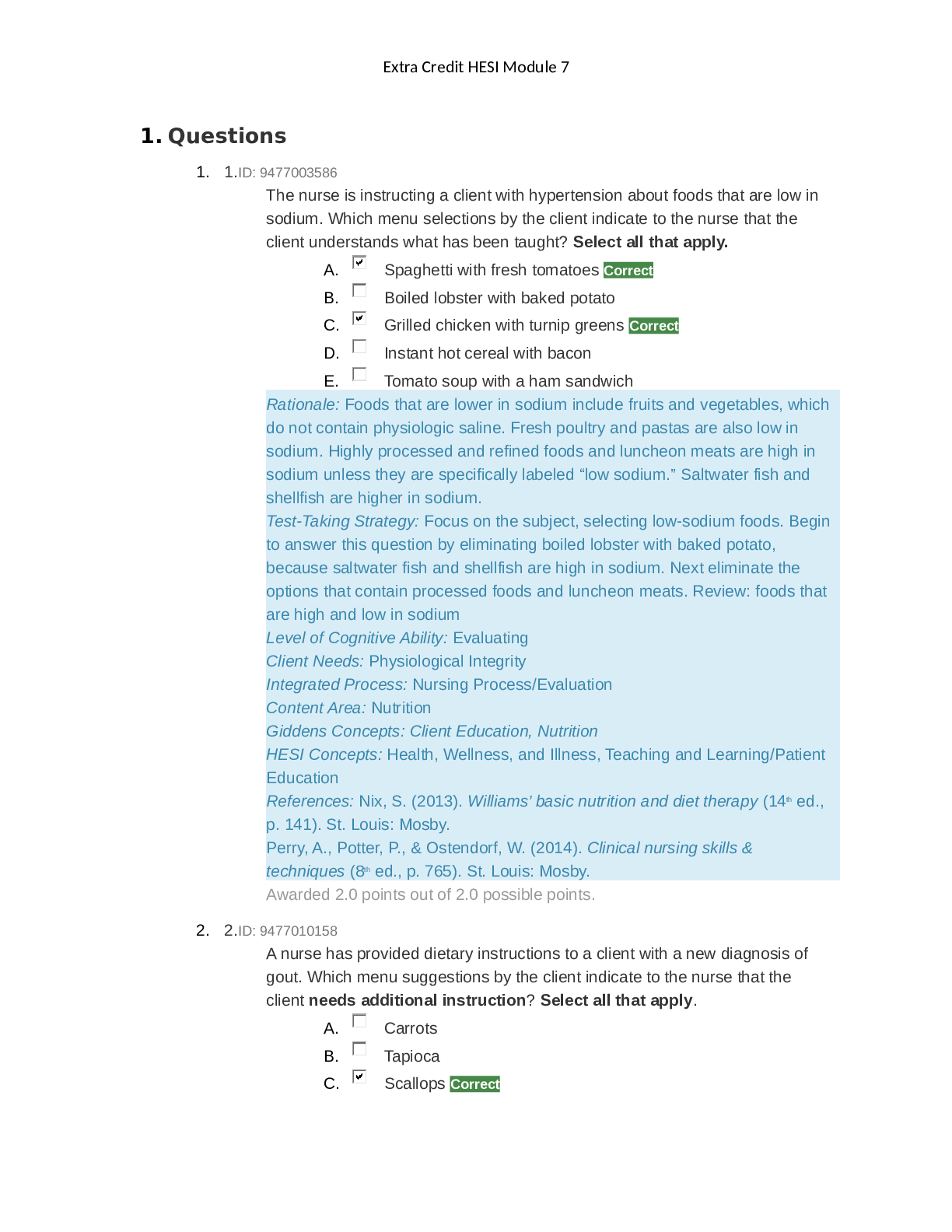
Reviews( 0 )
Document information
Connected school, study & course
About the document
Uploaded On
Jul 30, 2021
Number of pages
74
Written in
Additional information
This document has been written for:
Uploaded
Jul 30, 2021
Downloads
0
Views
34


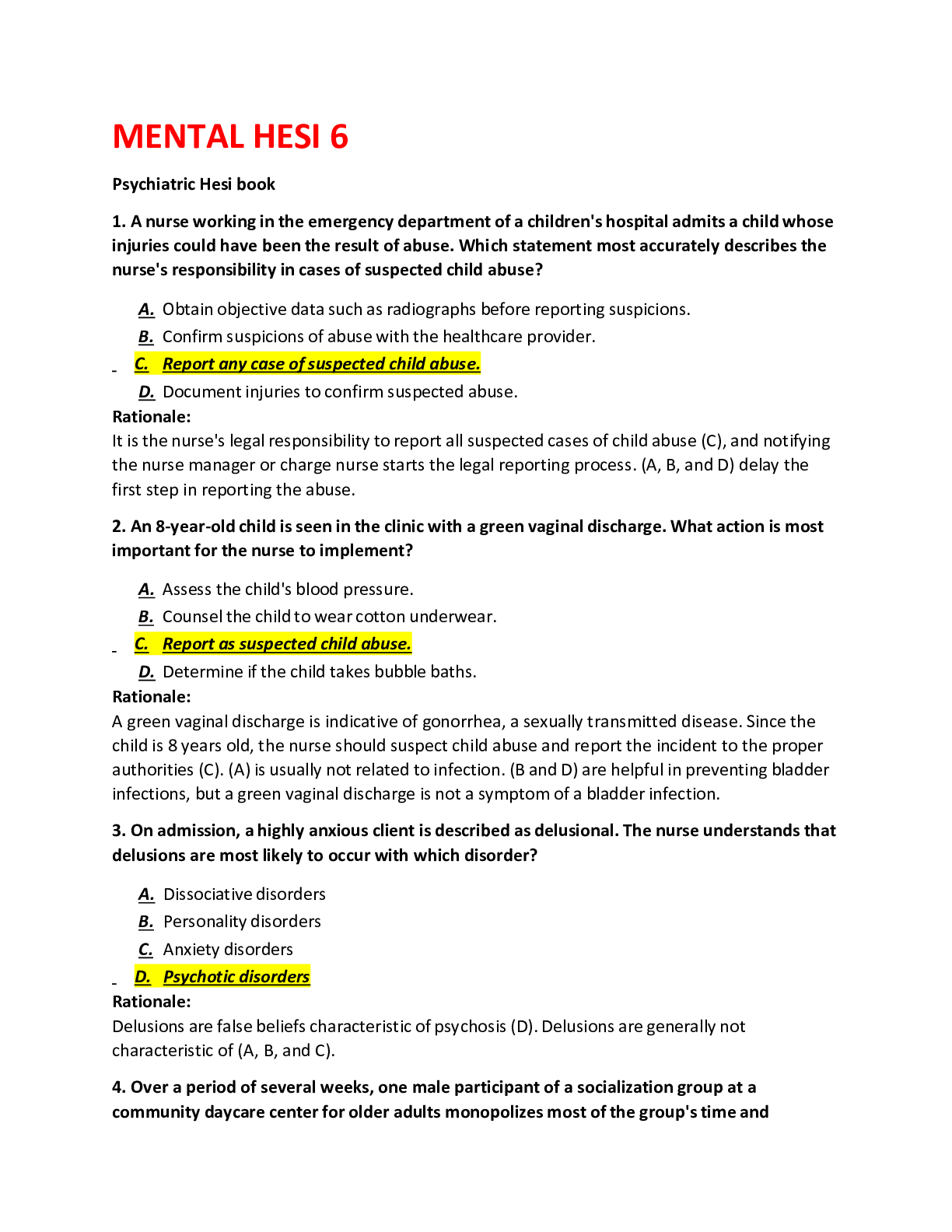
.png)
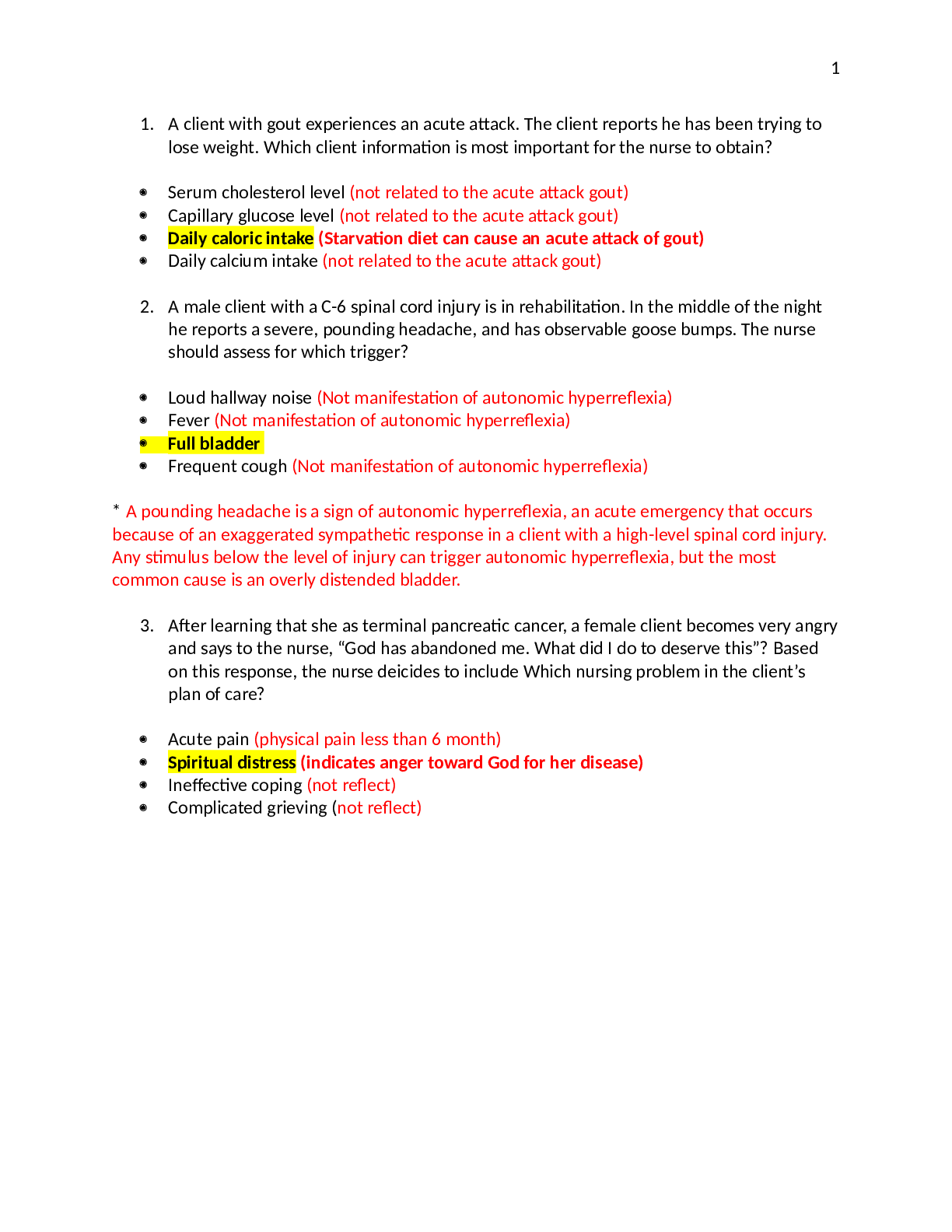
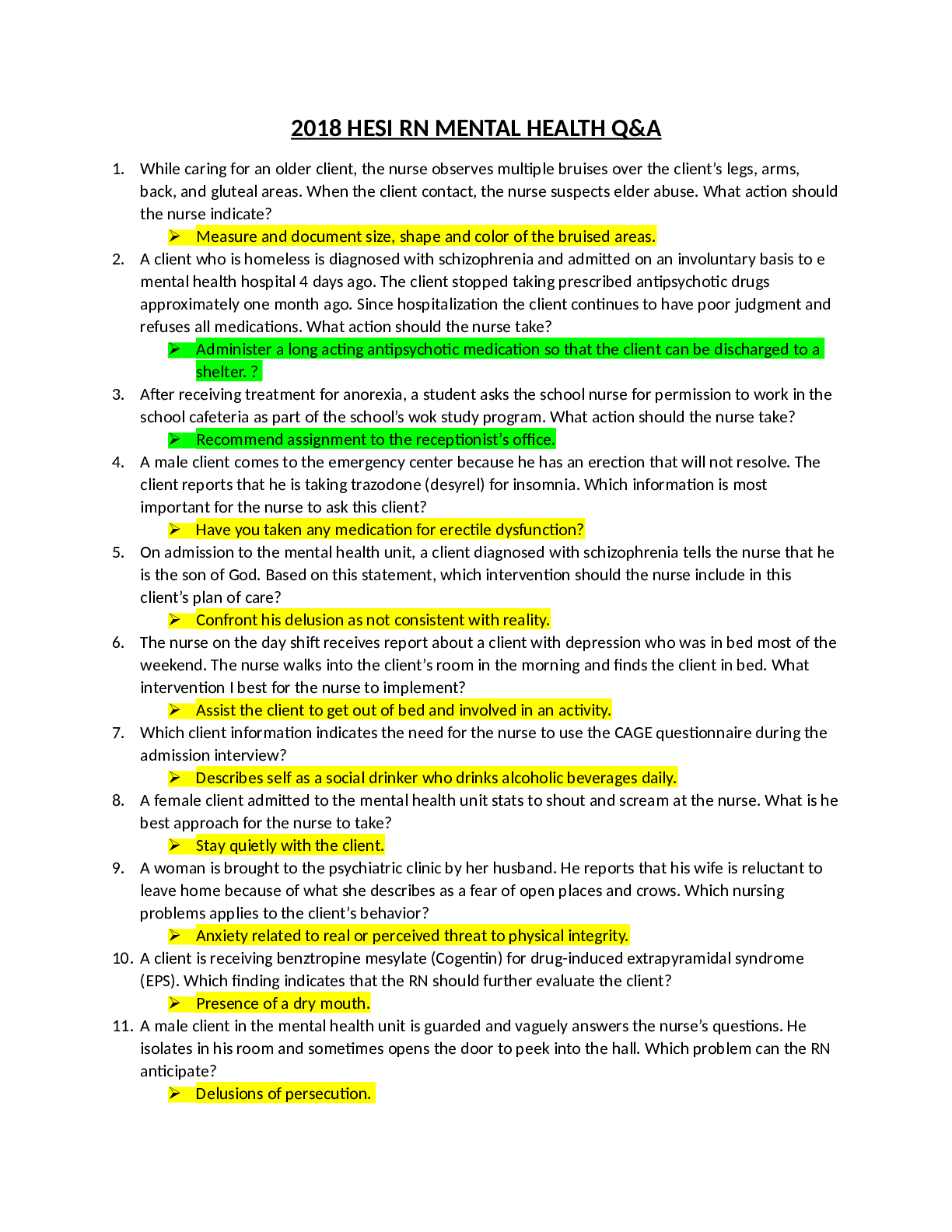
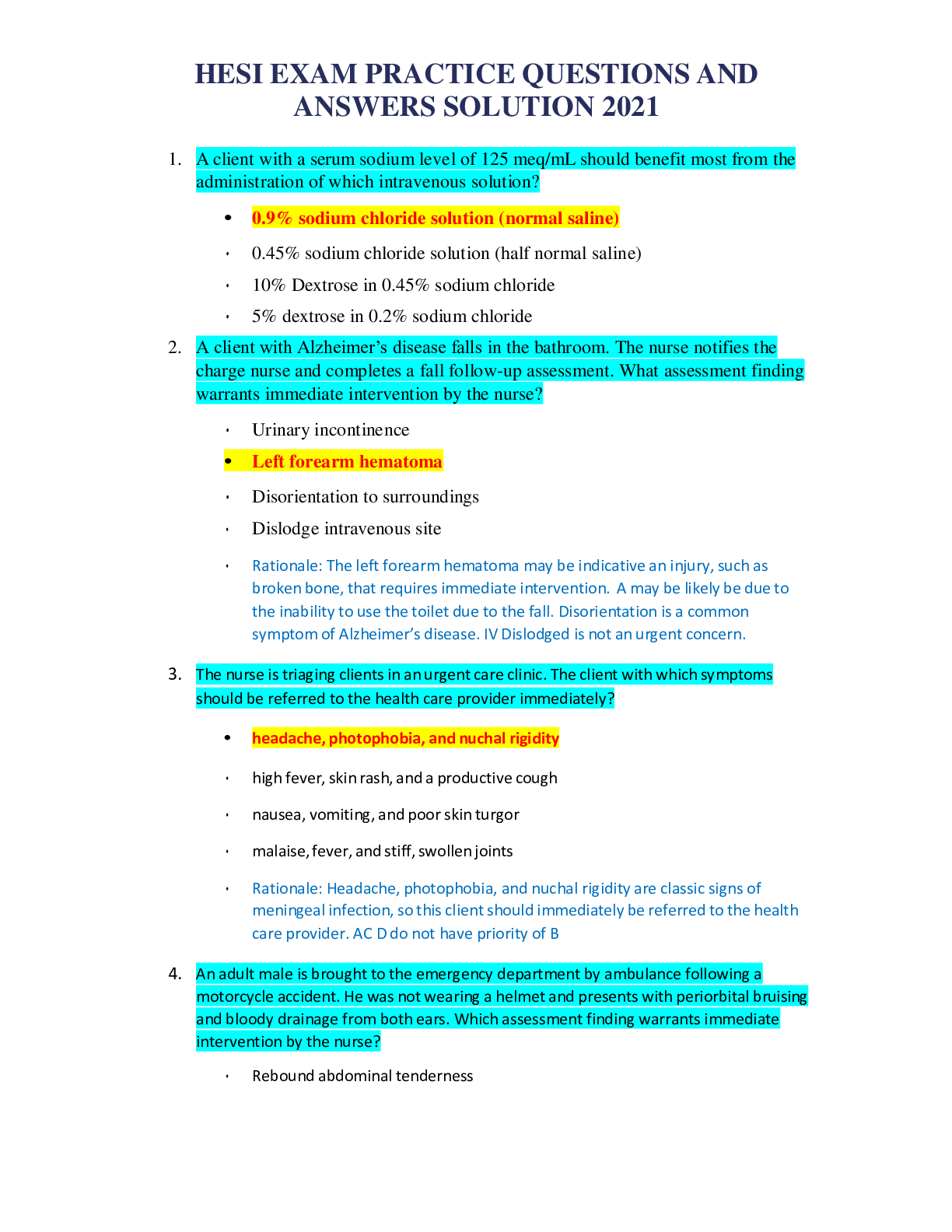
.png)

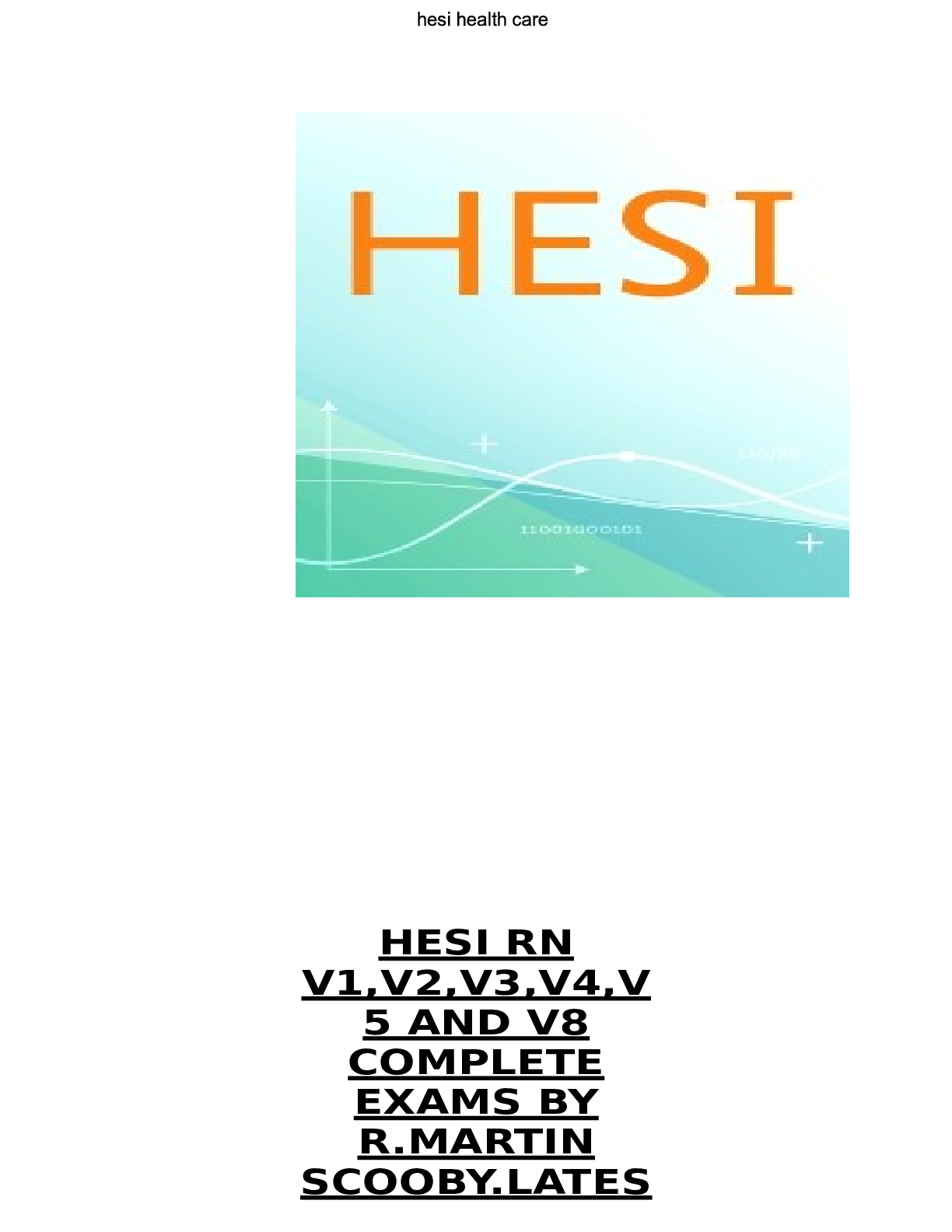
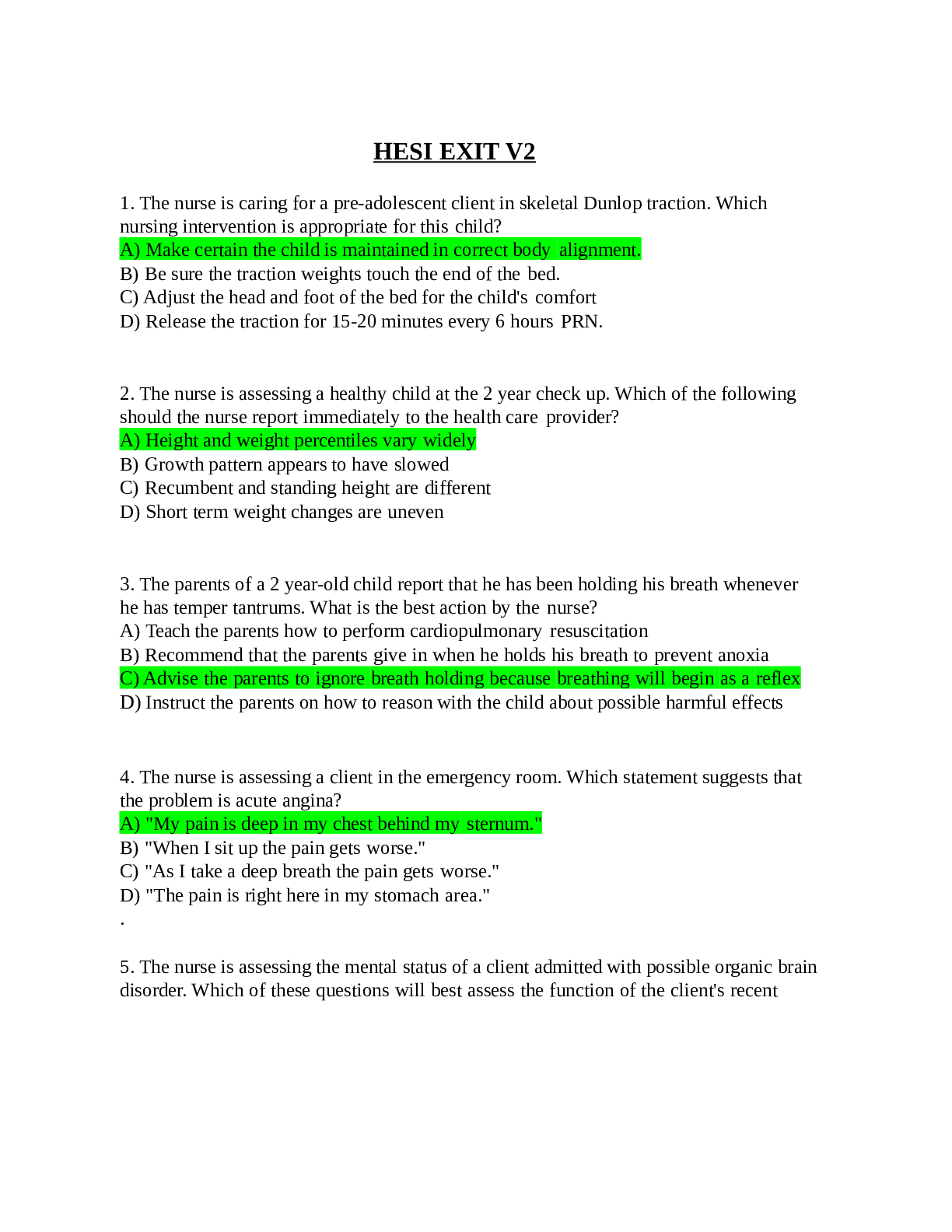
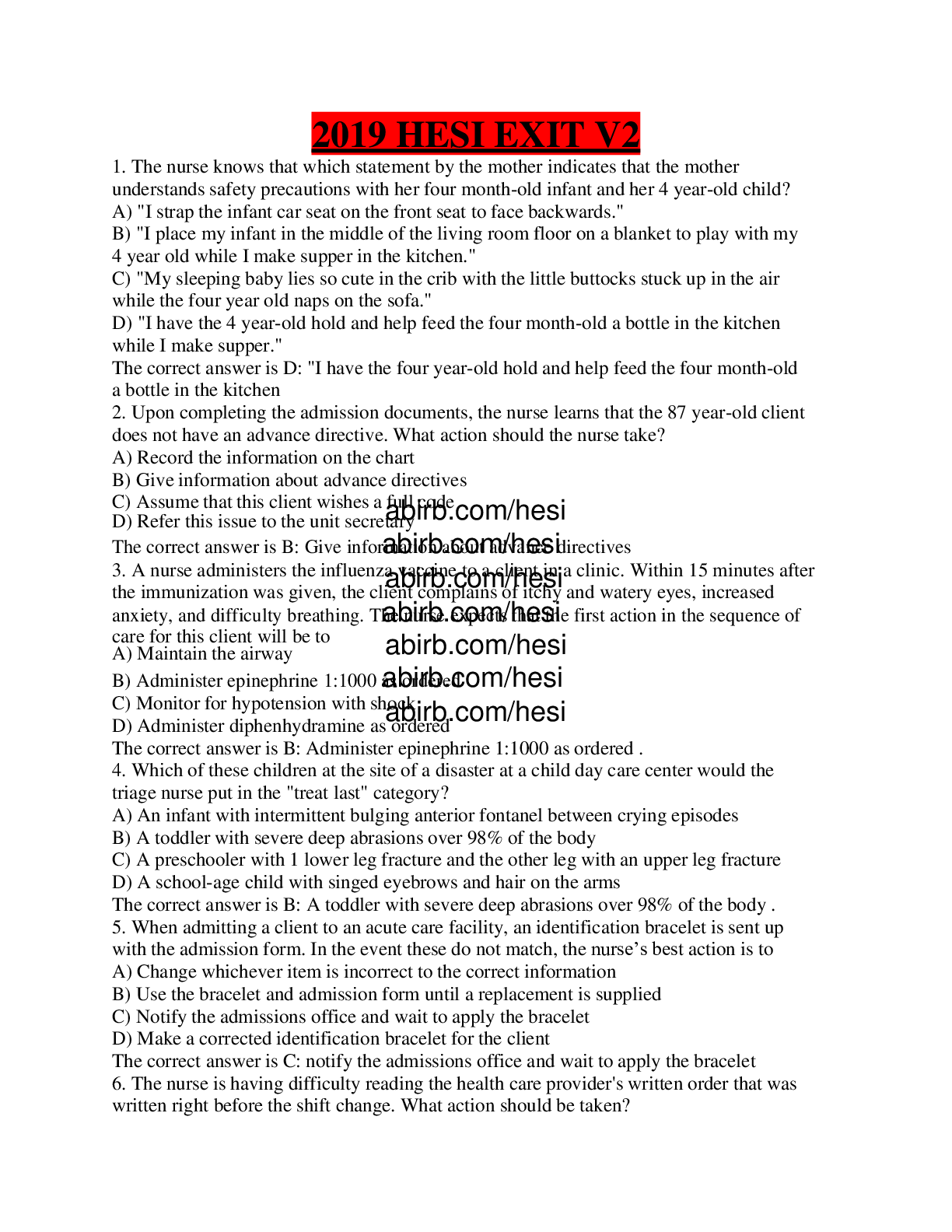
.png)
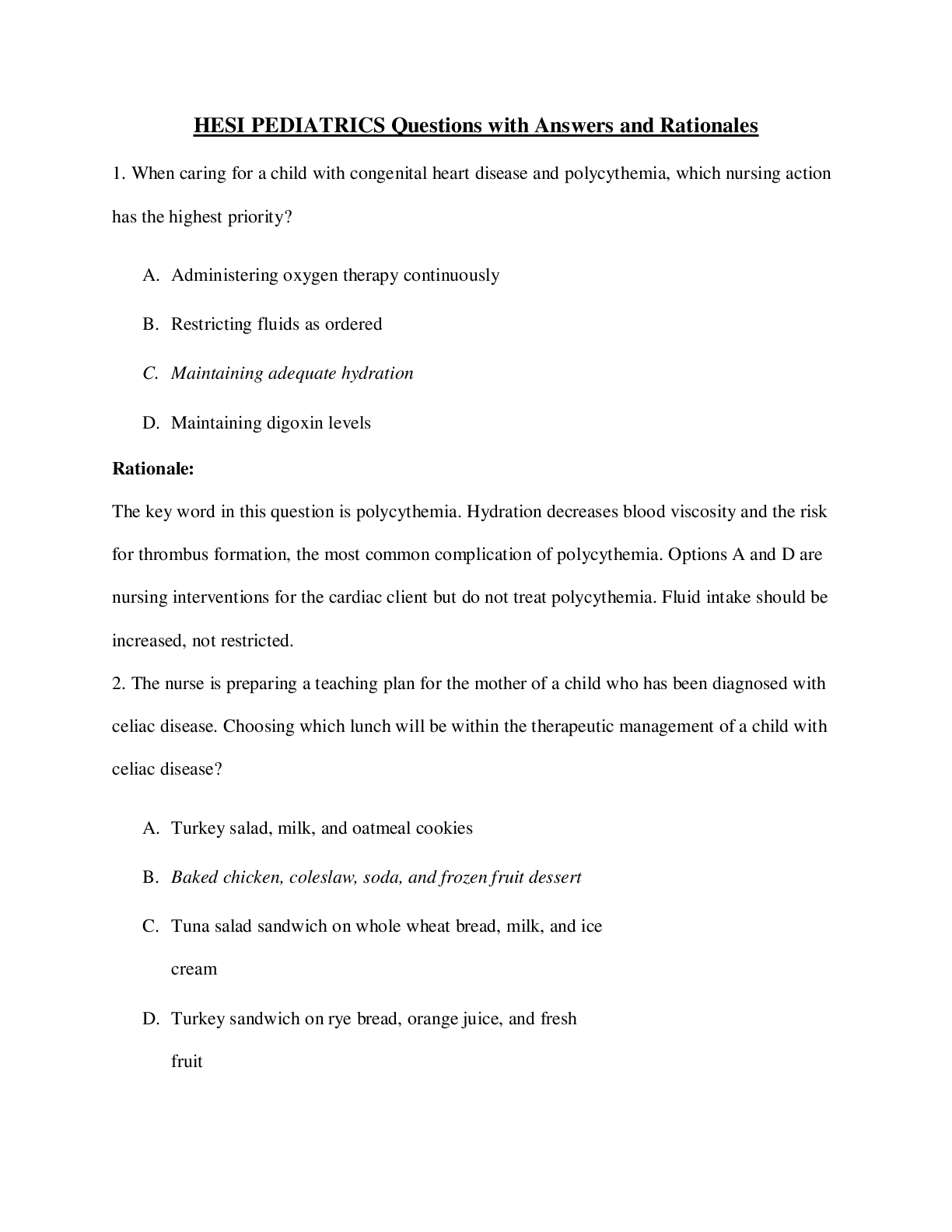
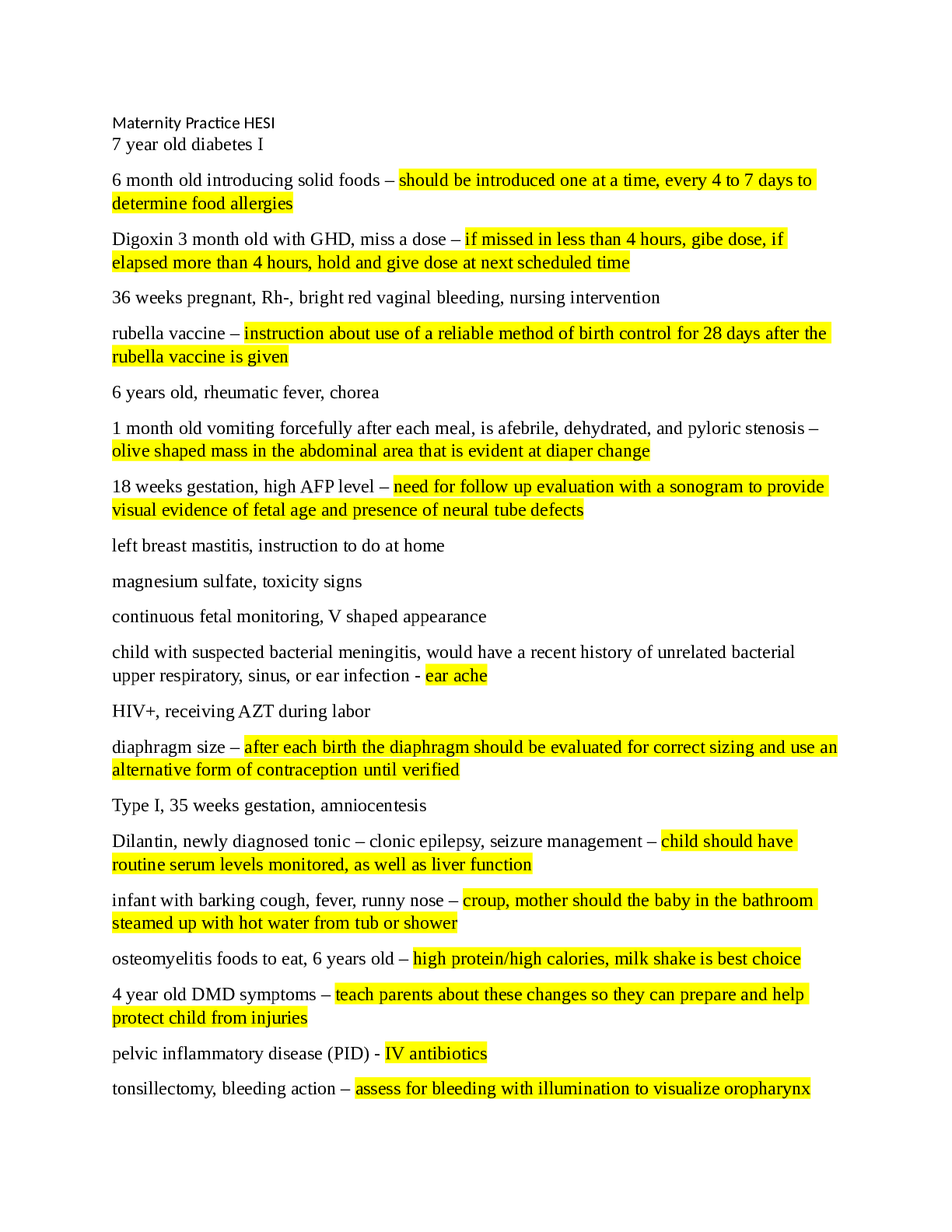
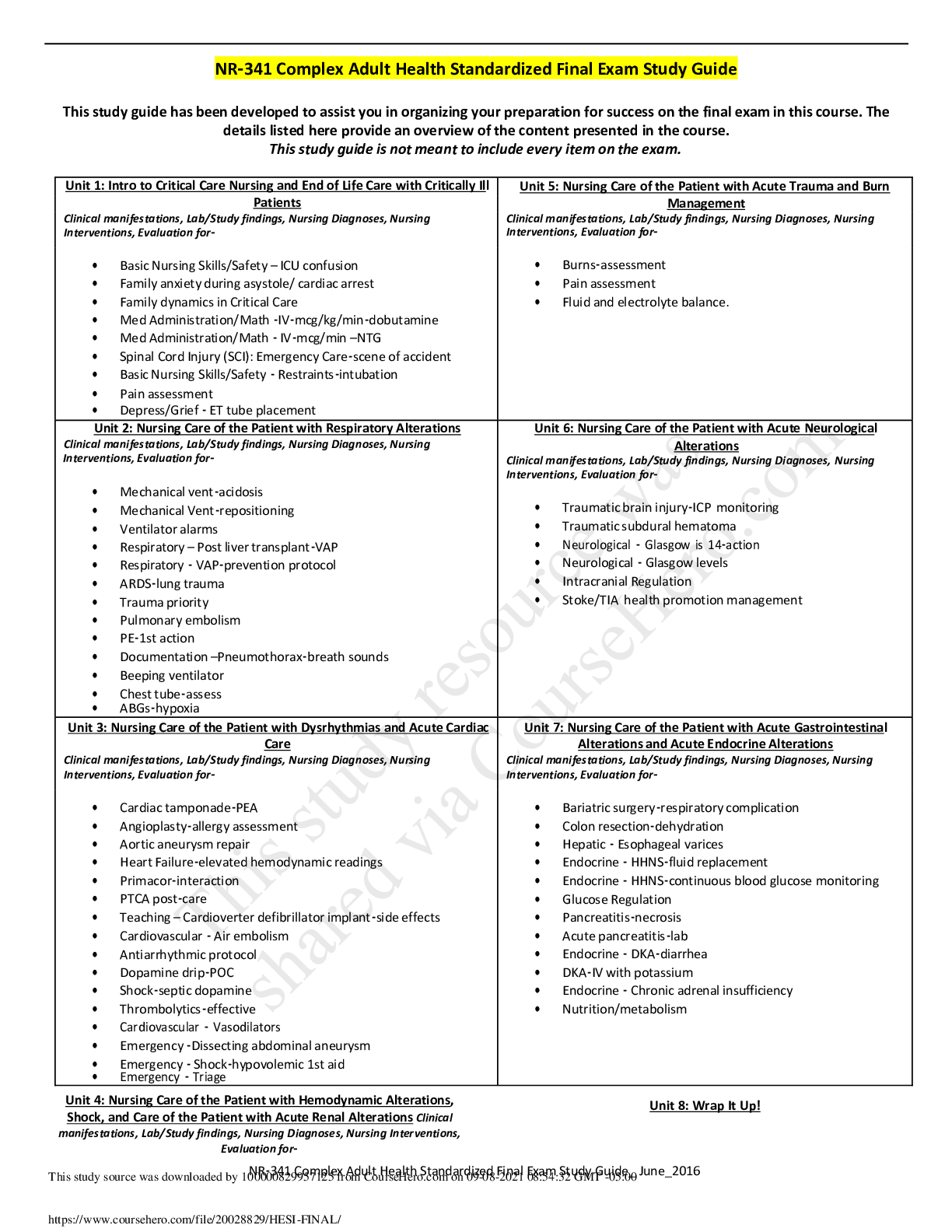
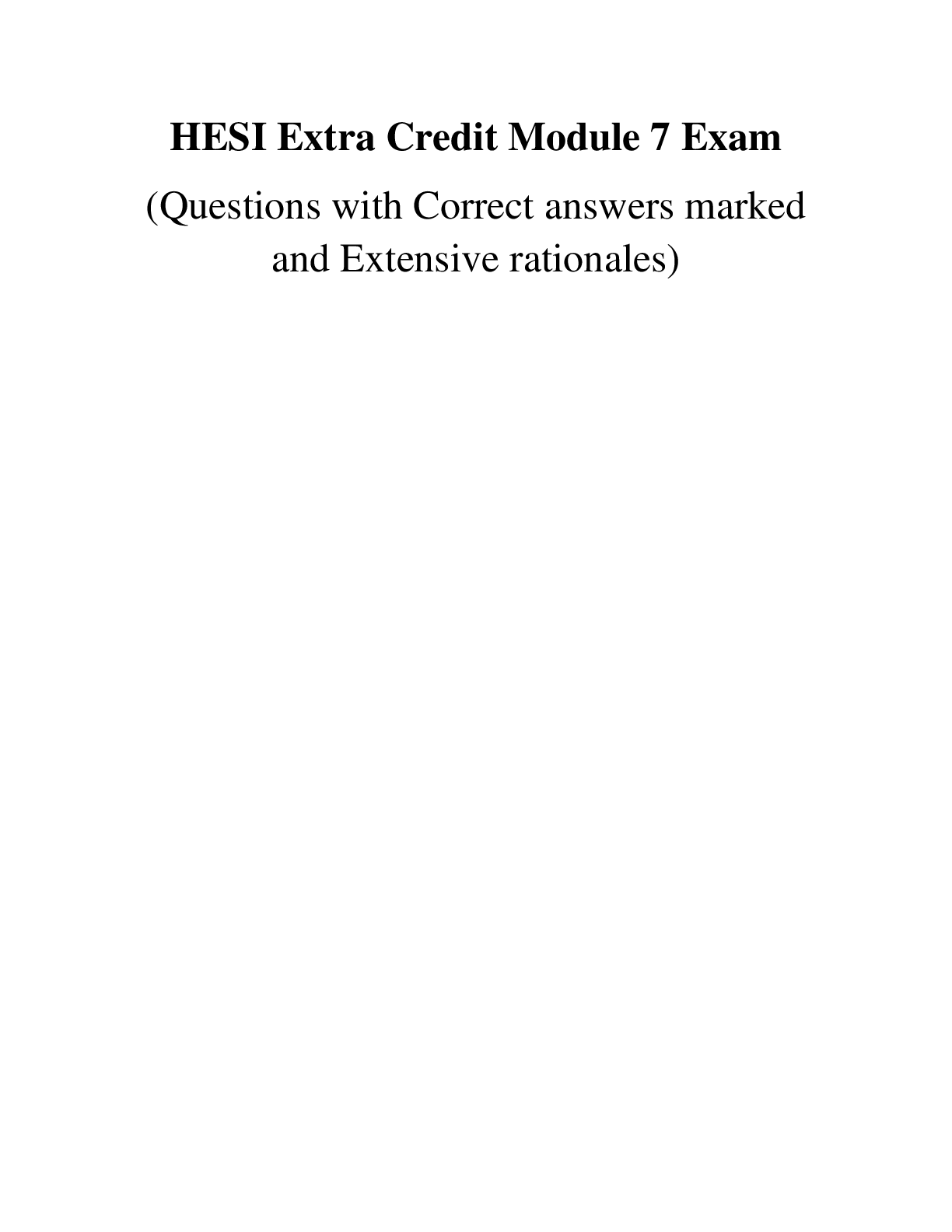
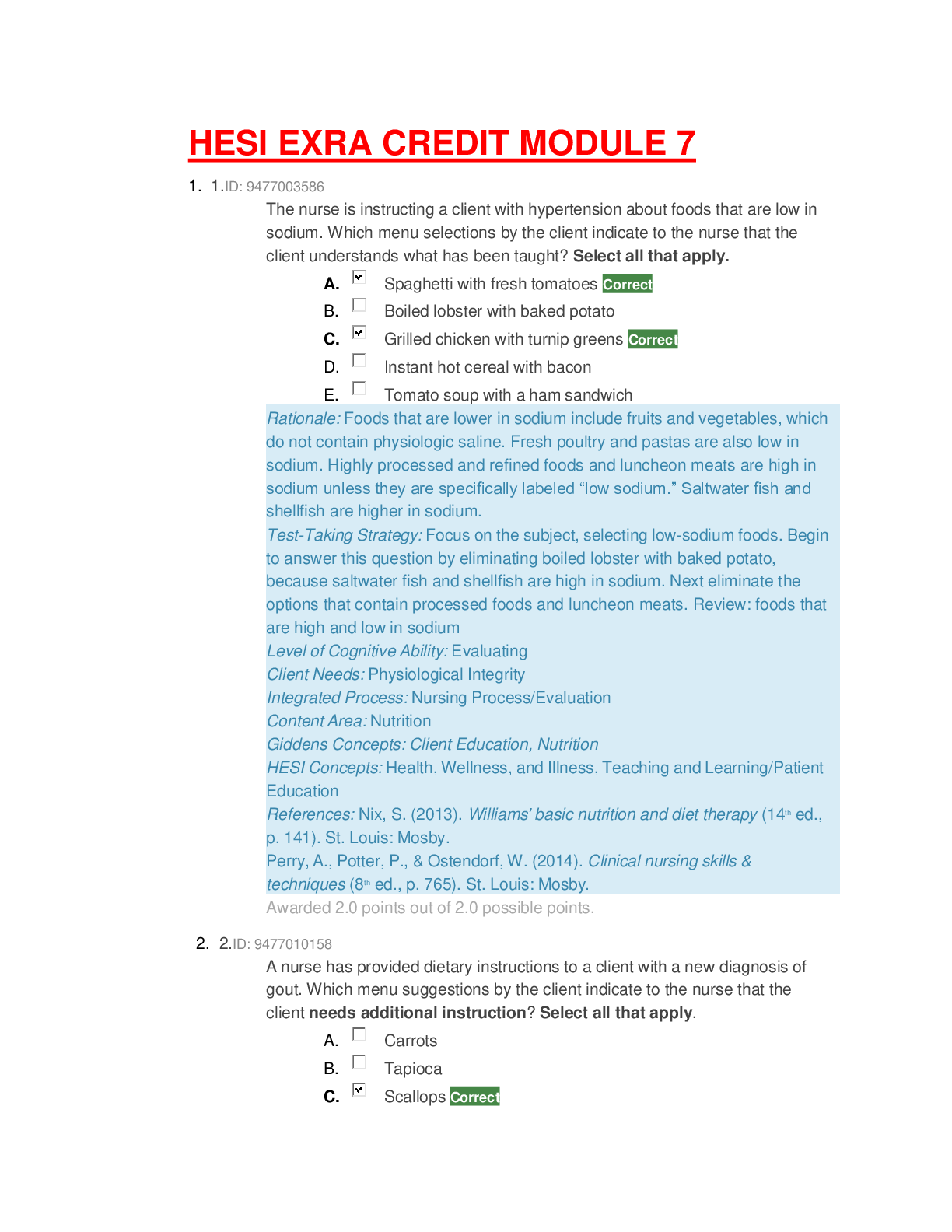




 (1).png)



